Llantrisant
Sub-Aqua Club
www.llantrisantdivers.com
|
|
|
|
|
|
|
|

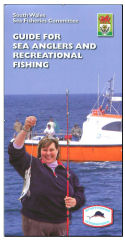


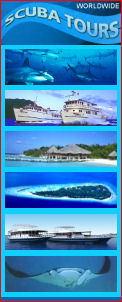
|
| |
|
Marine
Conservation & Underwater Photography
|
|
| |
| Meet
our Marine Conservation Officer - Mike Donovan |
|
 My
name is Mike Donovan and I have recently
(2018) taken on the role of Marine Conservation
officer for the club and I'm still working
out how to undertake the role. My
name is Mike Donovan and I have recently
(2018) taken on the role of Marine Conservation
officer for the club and I'm still working
out how to undertake the role.
 I
have lived in Cardiff all my life and have
two children (now adults) who live in Bangkok
and Liverpool. I
have lived in Cardiff all my life and have
two children (now adults) who live in Bangkok
and Liverpool.
My early career was with British Coal as
an industrial chemist, part of my duties
were environmental control keeping an eye
on local water sources to ensure we did
not exceed limits set by the environment
agency.
So I have some history in ensuring our waterways,
seas and oceans are not damaged by our activities.
I moved from the lab into management and
looked after a briquetting plant for a number
of years. When I left British coal I set
up a management consultancy helping companies
in South Wales to implementquality systems.
From there I moved into the public sector
helping local government and health trusts
to improve their performance. More recently
I have been focussing on helping individuals
with serious illnesses and their families
to cope the psychological effects.
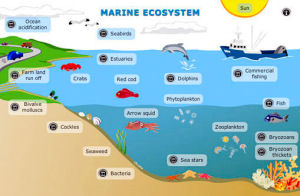 My
diving career started at the age of 14 but
was cut short partly due to a period of
illness with a prolonged recovery period,
but mostly due to a lack of funds. My
diving career started at the age of 14 but
was cut short partly due to a period of
illness with a prolonged recovery period,
but mostly due to a lack of funds.
I started diving again in my 50's and have
realised the enjoyment I have missed due
to my prolonged absence. We are so fortunate
to have the beautiful west coast of Wales
within easy reach and I try to spend a couple
of long weekends each month there.
I am committed to finding out what effect
the human race is having on the marine environment
and more importantly what we should be doing
about it.
To ensure I understand the issues I have
recently commenced a course in oceanography
delivered by Professor Tobin of the University
of Wisconsin-Madison. I will be developing
a E-newsletter to keep all those interested
in local, national and international marine
conservation issues.

|
Why
Marine Conservation?
|
Oceans
cover 70% of the Earth’s surface
and support an extraordinarily diverse
world. Only a fraction of it has been
discovered so far and much of ocean
life remains a mystery which we are
striving to unveil.
It is estimated that more than 1 million
species live on coral reefs alone, and
as many as 10 million in the deep seas.
The threats facing the marine environment
are numerous and complex yet less than
2% of the oceans are protected. |
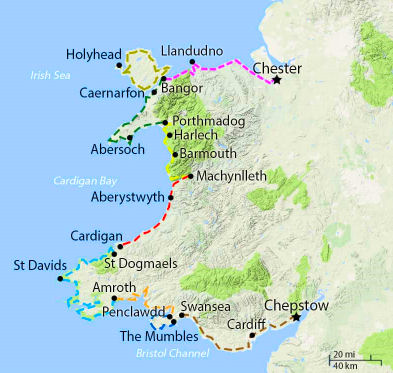 75%
of the Welsh coastline is recognised as
being of both national and European importance. 75%
of the Welsh coastline is recognised as
being of both national and European importance.
There's plenty of it too becasue Wales has
a staggering 2,740 km (1,702 miles) of coastline,
including offshore islands, dramatic cliffs,
secluded sandy beaches and rock pools to
explore.
All these provide a spectacular backdrop
for a range of leisure activities and watersports.
Wales
occupies a very unique position. It's on
the boundary of three oceanic and climatic
zones (North-east Atlantic, Arctic Boreal,
Lusitanian) and has one of the largest tidal
ranges in the world!
Those factors combine to make the marine
wildlife off Wales more diverse than many
other places in Europe.
Wales
also has heaps of different types of seabed
habitat, too, which provide ideal conditions
for a huge variety of species. The sea around
the country provides the perfect homes for
some of our favourite marine wildlife such
as seals, dolphins, porpoises, sharks, jellyfish
and many more.
|
|
|
|
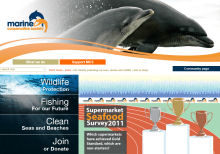 For
those keen to know more about our wonderful
diversity of marine life, see the Marine
Conservation Society publications and visit
their website at: For
those keen to know more about our wonderful
diversity of marine life, see the Marine
Conservation Society publications and visit
their website at:
www.mcsuk.org/
Mike
Donovan
Marine Conservation Officer.
><((())):>
|
|
|
|
| Milford
Haven oil spill estimated at 'up to 10,000 litres' (January
2019) |
|
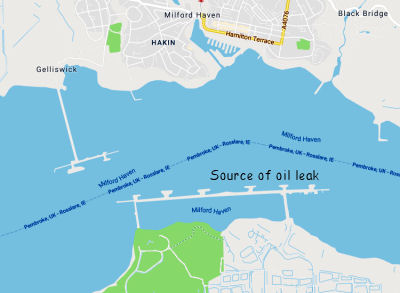 A
"heavy" oil spill which prompted a major clean-up
operation could be as much as 10,000 litres, port chiefs
have said. A
"heavy" oil spill which prompted a major clean-up
operation could be as much as 10,000 litres, port chiefs
have said.
The
Valero Jetty in Pembrokeshire, was closed off after
the leak on Thursday.
Officials
said the vast majority of the spill was contained -
although more tests are under way.
Andrea
Winterton, of Natural Resources Wales (NRW), said it
was difficult to predict what the environmental impacts
will be.
"We're
not sure where or when any further oil will come ashore...
but we'll keep monitoring all the beaches and working
with our partners to ensure where it does come ashore,
we clean it up appropriately," she said.
"The
oil has stopped, the leak has stopped... until there's
more that comes ashore, it's very difficult to say what's
happened to it and what the environmental impacts are
going to be."
The spillage was initially reported by the Valero refinery,
with the firm now estimating that 7,500 to 10,000 litres
(1,650 to 2,200 gallons) of "heavy fuel oil"
leaked overnight between 2 and 3 January.
As a comparison, the average household bath holds 80
litres of water.
It is understood the leak came from pipework.
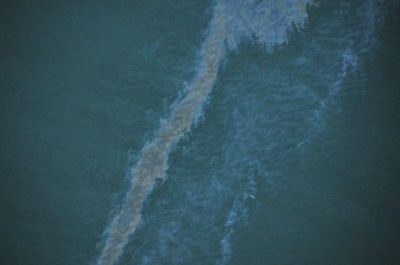 Habourmaster
Mike Ryan said a "well-rehearsed" clean-up
operation involved Natural Resources Wales, Pembrokeshire
County Council, Maritime Coastguard Agency as well as
Valero. Habourmaster
Mike Ryan said a "well-rehearsed" clean-up
operation involved Natural Resources Wales, Pembrokeshire
County Council, Maritime Coastguard Agency as well as
Valero.
Floating devices called "booms" were used
to contain most of the spillage and a drone has been
used to see where the oil has spread.
Officials said oil has been seen on the shore at Dale
and Musselwick Bay.
In the meantime, the boom devices will stay put until
NRW is "confident the risk" to wildlife and
sensitive salt marshes has passed.
The agency added a full investigation was under way.
|
| Ocean
Cleanup - The Great Pacific Garbage Patch |
|
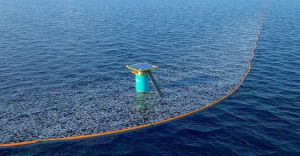 Scientists
are preparing to launch the world's first machine to
clean up the planet's largest mass of ocean plastic. Scientists
are preparing to launch the world's first machine to
clean up the planet's largest mass of ocean plastic.
The system, originally dreamed up by a teenager, will
be shipped out this summer to the Great Pacific Garbage
Patch, between Hawaii and California, and which contains
an estimated 1.8 trillion pieces of plastic.
It
will be the first ever attempt to tackle the patch since
it was discovered in 1997.
The
experts believe the machine should be able to collect
half of the detritus in the patch – about 40,000
metric tons – within five years.
In
the past few weeks they have been busy welding together
giant tubes that will sit on the surface of the sea
and form the skeleton of the machine, creating the largest
floating barrier ever made.
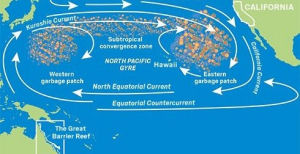 The
Great Pacific Garbage Patch (GPGP) spans 617,763 sq
miles - more than twice the size of France, and contains
at least 79,000 tons of plastic, research found last
month. The
Great Pacific Garbage Patch (GPGP) spans 617,763 sq
miles - more than twice the size of France, and contains
at least 79,000 tons of plastic, research found last
month.
Most
of it is made up of “ghost gear” – parts
of abandoned and lost fishing gear, such as nets and
ropes – often from illegal fishing vessels.
Ghost gear kills more than 100,000 whales, dolphins
and seals each year, according to scientific surveys.
Seabirds and other marine life are increasingly being
found dead with stomachs full of small pieces of plastic.
Creatures
eat plastic discarded in the sea thinking it’s
food but then starve to death because they are not feeding
properly.
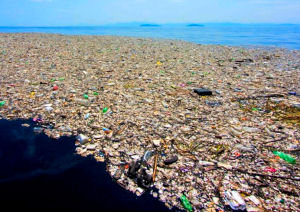 Others
are trapped and die of starvation or are strangled or
suffocated by ghost gear. Others
are trapped and die of starvation or are strangled or
suffocated by ghost gear.
More
than 8 million tons of plastic is dumped into our oceans
every year, according to the US-based Plastic Oceans
Foundation.
Up
to 90 per cent of the world’s plastic items are
never recycled, and scientists believe nearly every
piece ever created is still in existence somewhere,
in some form, with most going into landfill or the environment.
Single-use plastic, such as water bottles and nappies,
take 450 years to break down.
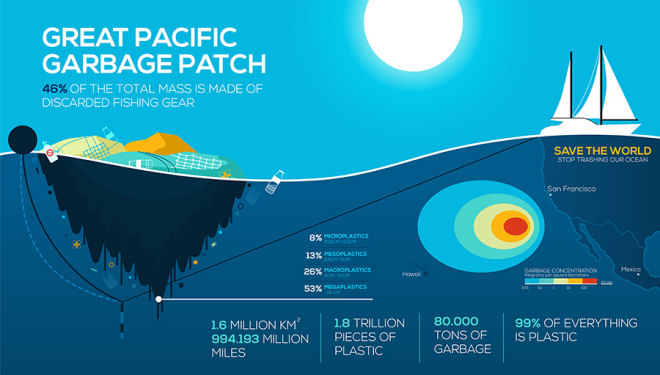
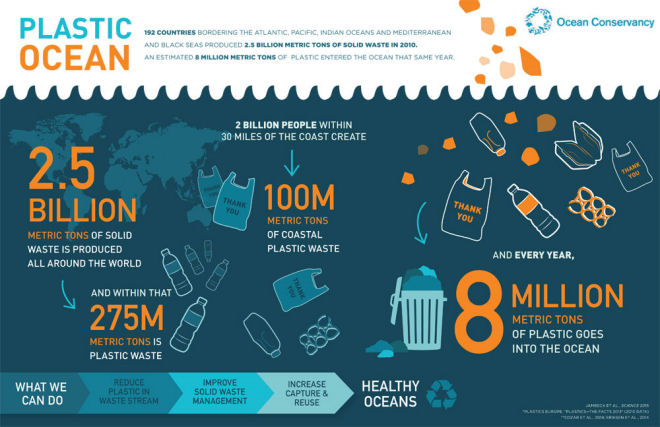
|
| Groundbreaking
project returns oysters to their original habitat |
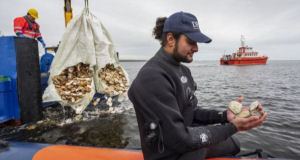 Native
oysters were common in the Dornoch Firth until they
were fished to extinction over a hundred years ago. Now,
as a partner in the Dornoch Environmental Enhancement
Project (DEEP, with Heriot-Watt University and Glenmorangie)
we are helping to return the oyster beds here to their
natural state. Native
oysters were common in the Dornoch Firth until they
were fished to extinction over a hundred years ago. Now,
as a partner in the Dornoch Environmental Enhancement
Project (DEEP, with Heriot-Watt University and Glenmorangie)
we are helping to return the oyster beds here to their
natural state.
20,000
oysters are now being carefully placed, on a bed of waste
shell that has been laid to mimic their natural habitat.
Following
a small-scale trial last year, this is the first time
that native oysters have been re-introduced to an area
where the species had become extinct, and promises potential
wider benefits for Scotland’s seas. Calum Duncan,
MCS Head of Conservation, Scotland, says: “Native
oysters flourished in the Dornoch Firth from up to 10,000
years ago before being wiped out in the 19th century.
Their return will enrich the ecosystem of an already internationally
important area of Scotland’s inshore waters.”
| We
are introducing more oysters to the Dornoch Firth
to recreate natural reefs where they once thrived,
giving benefits to the wildlife and water quality
of the area. |
The
native oysters, all grown in the UK, have been painstakingly
cleaned and checked for disease and unwanted “hitchhikers”,
and will be regularly monitored. Dr Bill Sanderson of
Heriot-Watt University
who is leading the restoration project said “While
this is on a much greater scale than last year’s
test introductions, we will be studying how well the oysters
fare, and their effects on the seabed around them. We
intend to ensure that sufficient numbers of oysters grow
in the area to make the reefs truly self-sustaining.”
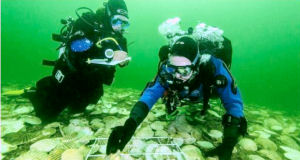 Hamish
Torrie, Glenmorangie’s Corporate Social Responsibility
director, said: “We are very excited to move DEEP
to its next stage and have been hugely encouraged by the
enthusiastic support that our meticulous, research-led
approach has received from a wide range of Scottish Government
agencies and native oyster growers – it is a truly
collaborative effort.” Hamish
Torrie, Glenmorangie’s Corporate Social Responsibility
director, said: “We are very excited to move DEEP
to its next stage and have been hugely encouraged by the
enthusiastic support that our meticulous, research-led
approach has received from a wide range of Scottish Government
agencies and native oyster growers – it is a truly
collaborative effort.”
Dr
Bill Sanderson, Associate Professor of Marine Biodiversity
at Heriot-Watt, said: “This is the first time anyone
has tried to recreate a natural European oyster habitat
in a protected area. We hope to create an outstanding
environment for marine life in the Firth – and act
as a driving force behind other oyster regeneration work
across Europe.
If
successful, this project will offer many benefits to the
marine environment, and will help inform conservationists
around the world in efforts to reintroduce similar native
species to areas where they have become extinct. As well
as helping to improve water quality, native oysters also
create microhabitats for other marine life, which increases
an area’s biodiversity.
|
| Brexit
and our Seas - MCS report |
|
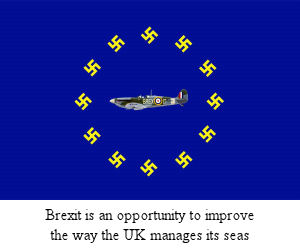 Did
you know that sadly, many of our environmental laws
- from how we manage our fisheries, to standards on
marine pollution, to how we protect many species and
habitats - come from the European Union? Did
you know that sadly, many of our environmental laws
- from how we manage our fisheries, to standards on
marine pollution, to how we protect many species and
habitats - come from the European Union?
The
UK has the third largest coastline in the EU, and
our waters and many of the species that dwell within
them know no boundaries. Joined up effort with our neighbouring
nations must take place if we are to manage our seas
well.
With
the UK set to leave the EU, it is a priority for
MCS to make sure that such a joined up approach continues
after the UK leaves the EU, to make sure that we keep
improving the management of our seas.
Laws
which are currently set at an EU level are being, or
will be reviewed to apply at a UK and devolved national
level. As a UK based and focussed marine charity, we
will work tirelessly to make sure the UK uses this as
an opportunity to truly become a world leader and build
on the good progress made in many areas of marine management.
Britain
used to enjoy fishing areas that extended up to
200 miles from our coast. Under the terms under
which we joined the EU, this distance was reduced
to just 12 miles – and even that has depended
on a concession that has to be renewed every 10
years.
EU rules are crass and wasteful into the bargain,
with thousands of tonnes of fish being discarded
– just thrown away. And if this were not bad
enough, we have to donate British taxpayers’
money to other fishing countries. |
Our
priorities for UK seas
We
need to:
-
Ensure
new domestic fisheries laws deliver sustainable
fisheries.
-
Complete
an ecologically coherent network of well managed
marine protected areas.
-
Uphold
and effectively implement into UK laws all our obligations
under international environmental treaties so that
they can be given effect in the laws of England,
Wales, Northern Ireland and Scotland, and are legally
enforceable.
-
Continue
to take action to reduce marine litter; in particular,
implement the circular economy package, plastics
strategy and reforms to Port Waste Reception Facilities
Directive.
-
Protect
vulnerable deep sea ecosystems from damaging fishing
practices.
What
is MCS doing?
We
are collaborating with several partners to define what
Brexit will mean for our seas, and to devise the best
course of action to ensure that our priorities are achieved:
-
We
made our recommendations clear with a letter, sent
to all major UK political parties shortly after
last year’s snap election (June 2017).
-
We
sent a letter on “UK fisheries and the marine
environment after we exit the EU” to Defra
ministers (July 2017).
-
We
provided parties with details of the Greener UK
manifesto, which we support alongside many partner
charities.
-
Worked
in a coalition with other charities to develop this
briefing “Delivering sustainable fisheries
management, A sustainable future for UK seas”.
-
Worked
in coalition with the Greener UK Fisheries and Aquaculture
Pillar to develop this briefing “Essential
elements of sustainable fisheries management”
and a series of more detailed parliamentary briefings.
-
Working
in coalition with the Greener UK Fisheries and Aquaculture
Pillar, we helped develop these case studies to
help highlight key elements that the proposed new
Fisheries Bill needs to address.
-
We
actively work in coalition with Wildlife and Countryside
Link in England, Welsh Environment Link, Scottish
Environment Link, and the Northern Irish Marine
Task Force where we have helped develop various
briefings and recommendations for Brexit.
-
Responded
to the Labour Party consultation on Brexit and fisheries.
-
Have
been regularly meeting with civil servants and Ministers
from England, Scotland and Wales to provide advice
and recommendations and ask pertinent questions
about future management arrangements. * Responded
to a consultation on the government’s proposed
Environmental Principles and Governance after EU
Exit. * Marine Conservation Society’s submission
to Defra to highlight the importance of protecting
the deep sea post Brexit.
-
Marine
Conservation Society’s submission to the Defra
consultation on its White Paper: Sustainable Fisheries
for Future Generations.
What’s
next?
We
will:
-
Respond
to any consultations on the recently announced new
Environment Bill.
-
Respond
to the consultation on the Government’s ‘Sustainable
Fisheries for Future Generations’ document
(the Government White Paper outlining post-Brexit
plans for fisheries management) where, amongst other
things, we are concerned that the brand new Fisheries
Bill will not include important environmental objectives.
More here.
-
Encourage
the public to respond to this important, once in
a generation, consultation.
-
Continue
to work in coalition with the charities on the Greener
UK Fisheries and Aquaculture Pillar and the various
Environment Links of the United Kingdom, to develop
agreed positions and provide joint briefings and
submissions.
-
Continue
to meet with civil servants and UK Ministers and
the devolved administrations to provide advice and
recommendations and ask key questions about future
management arrangements.
-
Keep
working with the North Sea and North Western Waters
Advisory Councils to provide fisheries management
advice to the EU Commission and regional Member
States, especially on any Brexit related advice
developed.
-
Continue
to engage the public and encourage them to support
and call for better managed UK seas and and sustainable
fisheries and responsible aquaculture (see the Good
Fish Guide).
-
Continue
to work with OSPAR to ensure that the Regional Action
Plan on marine litter is also implemented in the
UK.
-
Work
to make sure any new regulatory body has powers
and “teeth” to ensure environmental laws
and standards are upheld and more effective in future.
|
| Is
the marine environment a political priority? |
|
 October
2018 - The party conference season is over for another
year and MPs return to Parliament next week. Over the
last month each of the major political parties headed
to cities around the UK where they were joined by an
eclectic mix of party members, corporate lobbyists,
CEOs, and policy and public affairs leads from charities,
NGOs and other groups with an interest in influencing
policy. October
2018 - The party conference season is over for another
year and MPs return to Parliament next week. Over the
last month each of the major political parties headed
to cities around the UK where they were joined by an
eclectic mix of party members, corporate lobbyists,
CEOs, and policy and public affairs leads from charities,
NGOs and other groups with an interest in influencing
policy.
The days are long, filled with fringe events,
conference speeches, meetings with MPs and drinks receptions
where everyone hopes to chat to a minister. The food
is bad (I don’t want to see another sandwich for
a long time!) and a lot of time is spent queuing, but
it gives organisations such as MCS a valuable opportunity
to glean intelligence about upcoming policy changes,
question politicians and ensure that the issues we care
about are on the political agenda.
There was strong focus on the marine environment
in Michael Gove’s speech with assurances that the
UK will fish sustainably after EU exit, that 30% of
the world’s oceans will be protected, we will have
a Green Brexit and that we must “action this day”
on ocean plastic. Whilst this positivity is to be welcomed,
we’re still waiting for many policy announcements
and consultations on plastic. We’re yet to see
the draft Fisheries Bill or the government response
to the recent consultations on the fisheries white paper
and marine conservation zones. We still haven’t
got clarity on a single-use plastic tax or on environmental
principles and governance after Brexit. The longer we
wait the more plastic enters our oceans and the more
marine wildlife suffers due to lack of adequate protection.
So we really need to see some action.
Encouragingly,
a number of Conservative environmental
fringe events focused on ocean plastic (most of which
were standing room only with queues out the door!).
MPs spoke about the Blue Planet effect and had clearly
been influenced by this and the recent huge public response
to the consultation on single-use plastic.
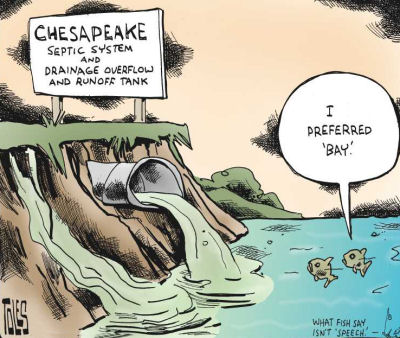 Thérèse
Coffey MP confirmed that the Waste and Resource Strategy
is expected this month (but will definitely be out before
Christmas!) and that there will be an announcement on
taxing single-use plastic and changes to the waste collection
system to make it simpler. On a deposit return scheme,
she mentioned that this is more complex than people
think. It’s clear that we must do more to dispel
the argument being pushed by industry that a deposit
return scheme should apply to “on-the-go”
items only. Thérèse
Coffey MP confirmed that the Waste and Resource Strategy
is expected this month (but will definitely be out before
Christmas!) and that there will be an announcement on
taxing single-use plastic and changes to the waste collection
system to make it simpler. On a deposit return scheme,
she mentioned that this is more complex than people
think. It’s clear that we must do more to dispel
the argument being pushed by industry that a deposit
return scheme should apply to “on-the-go”
items only.
At the Labour Party Conference Jeremy Corbyn (not dancing,
but definitely upbeat) announced some bullshit about
plans to reduce greenhouse gas emissions to zero and
a green jobs revolution to tackle climate change. Sue
Hayman, Labour’s Shadow Environment Secretary,
launched a joint report with the Shadow Business Secretary
and highlighted the need for departments to work together
on making sure that there is a focus on the environment
in decision-making. The Treasury was singled out as
a major blocker to environmental change. It is a welcome
step forward to see these environmental commitments
from Labour and let’s hope we see more action through
future policy announcements.
Labour also confirmed an ambition towards standardising
recycling regimes across councils and the need for extended
producer responsibility. The commitment to a deposit
return scheme was confirmed and there was strong support
for an ambitious Environment Bill with a watchdog with
teeth to hold all public bodies to account after EU
exit.
In conclusion, whilst the rhetoric was strong
from both parties - at the end of the day actions speak
louder than words. For everyone who saw the heartbreaking
scenes of the flesh-footed shearwater chick vomiting
up plastic in the excellent Drowning in Plastic documentary,
there can be no greater sign that the Government needs
to take urgent action on behalf of our marine environment.
The future of our oceans depends on it.
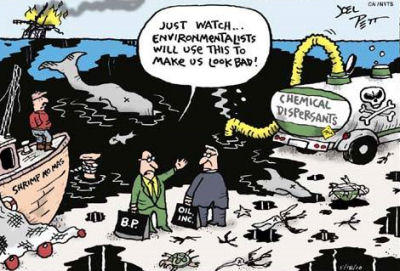
|
| Swansea
Bay Tidal Lagoon is given the "go ahead"; or
has it? |
|
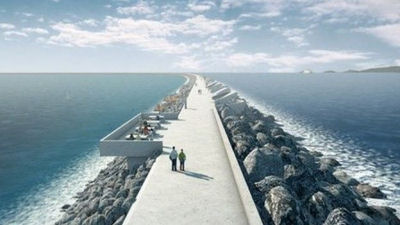 A
£1bn plan to build the world's first power-generating
tidal lagoon in Swansea Bay has been given the "go
ahead". A
£1bn plan to build the world's first power-generating
tidal lagoon in Swansea Bay has been given the "go
ahead".
The Severn Estuary holds the second highest tidal range
in the world and within this Swansea Bay benefits from
an average tidal range during spring tides of 8.5m.
The construction of a tidal lagoon to harness this natural
resource would help the UK transition a low carbon future
with greater energy security and lower electricity costs,
while providing regenerative economic and recreational
benefits to the local community.
Energy Secretary Ed Davey said it showed the UK government
was "serious" about the potential for tidal
power. "Tidal energy is a huge opportunity for
Britain," said Mr Davey.
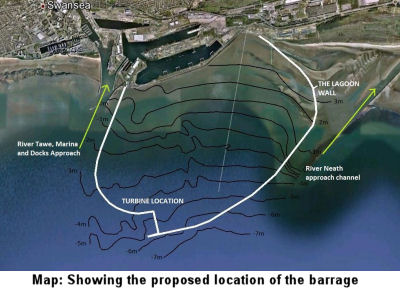 "Tidal
lagoons alone could provide up to 8% of our power needs,
replacing foreign fossil fuels with clean, reliable
home-grown electricity. "Tidal
lagoons alone could provide up to 8% of our power needs,
replacing foreign fossil fuels with clean, reliable
home-grown electricity.
"That's why we're showing investors and developers
that we're serious about tidal lagoon potential and
have started in-depth discussions for what could become
the world's first tidal lagoon.".
Welsh Secretary Stephen Crabb welcomed progress on the
scheme, saying it could give a "massive boost"
to the Welsh economy, creating thousands of jobs. "Wales
is already home to some of the most cutting edge companies
in the world and the country is uniquely placed to pioneer
tidal power,".
"I am a strong supporter of this project and I
have long been making the case to my Cabinet colleagues
that Welsh innovation should be supporting the next
generation of low-carbon technology."
HOW THE LAGOON WOULD WORK:
-
A
six-mile long seawall loops two miles out to sea
from close to the mouth of the River Tawe and Swansea
Docks and make landfall close to Swansea University's
new Fabian Way campus to the east.
-
It
would house 16 underwater turbines generating electricity
on both the rising and falling tide.
-
Enough
renewable power would be produced for 155,000 homes
(equivalent to 90% of Swansea Bay's annual domestic
electricity use) for 120 years.
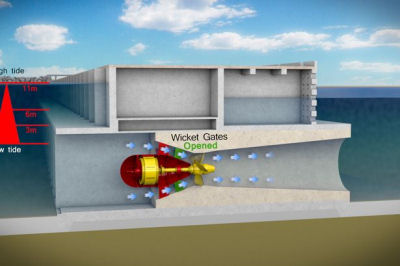 Tidal
lagoons are a simple concept involving the adaptation
of standard, proven components used in global engineering
projects. The Swansea Bay lagoon will comprise a UK
standard sand-core breakwater or rock bund, similar
to many seen in coastal defence schemes and harbour
walls. Tidal
lagoons are a simple concept involving the adaptation
of standard, proven components used in global engineering
projects. The Swansea Bay lagoon will comprise a UK
standard sand-core breakwater or rock bund, similar
to many seen in coastal defence schemes and harbour
walls.
The generating equipment of bulb hydro turbines have
been used for many years on run-of-river hydro power
schemes as well as some landmark tidal barrages. The
hydro turbines are mounted inside concrete turbine housings
and are permanently submerged so the resulting view
is of a ring-shaped harbour wall with one section of
concrete casing.
As
the sea outside the breakwater rises and is held back
a difference in water levels is created, known as ‘head’,
and once a sufficient head height is reached sluice
gates are opened and water flows into the lagoon through
turbines to generate electricity.
This process then occurs in reverse, on the ebb tide,
as sea levels start to fall and a tidal head is created
by holding water back within the lagoon. This way the
tides can flow through our turbines four times daily
to generate power.
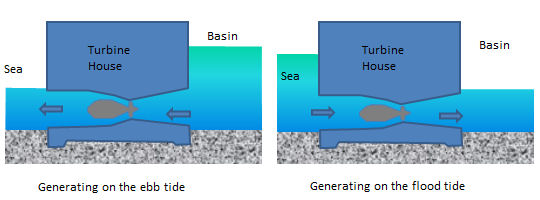
|
| Marine
Current Turbines kicks off first tidal array for Wales |
|
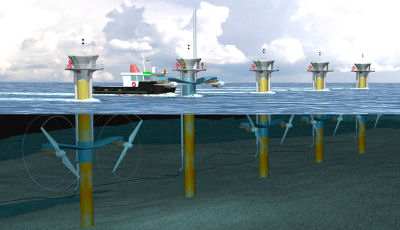 Marine
Current Turbines Ltd (MCT), in partnership with RWE
npower renewables, has today submitted a consent application
to install a 10MW array of tidal stream turbines off
the North West coast of Anglesey in 2015. Marine
Current Turbines Ltd (MCT), in partnership with RWE
npower renewables, has today submitted a consent application
to install a 10MW array of tidal stream turbines off
the North West coast of Anglesey in 2015.
The array, consisting of seven twin rotor turbines arranged
across an area of 0.56km², will harness the power
of the tidal waters, generating enough power for over
10,000 homes on the island. It will be the first tidal
array to be deployed in Wales.
This
tidal farm, using the fast moving and predictable flow
of the tides, will use MCT’s proven and award-winning
tidal energy technology (known as SeaGen and which works
in principle like an underwater windmill) to generate
enough power to supply electricity to up to 10,000 homes.
The array will be situated between the Skerries islands
and Carmel Head, about 1km off the Anglesey coast. SeaGen
is a proven technology, the first 1.2MW unit having
been successfully operated in Strangford Narrows, Northern
Ireland since 2008, and it is officially accredited
by OFGEM as the UK’s first and only tidal current
power plant.
If
the planning consent is granted to SeaGeneration Wales
Ltd, the MCT / RWE npower renewables project company,
it will be the first tidal array in Wales demonstrating
the commercial viability of this technology. This project
will help to demonstrate that the deployment of tidal
generation can be recognised as a viable means of securing
renewable generation, lower carbon emissions whilst
simultaneously creating a new industry and many jobs.
Martin
Wright, founder of MCT said: “Tidal power is
a predictable and reliable source of renewable energy
and our technology can play an important part in helping
Wales realise its renewable energy targets as set out
in the Welsh Assembly Government (WAG) Energy Policy
statement.
|
| Climate
change PROVED to be 'nothing but a lie'; claims top meteorologist |
|
 The
debate about climate change is finished - because it
has been categorically proved NOT to exist, one of the
world's leading meteorologists has claimed. The
debate about climate change is finished - because it
has been categorically proved NOT to exist, one of the
world's leading meteorologists has claimed.
John Coleman (right), who co-founded the Weather Channel,
shocked academics by insisting the theory of man-made
climate change was no longer scientifically credible.
Instead,
what 'little evidence' there is for rising global temperatures
points to a 'natural phenomenon' within a developing
eco-system.
In an open letter attacking the Intergovernmental Panel
on Climate Change, he wrote:
-
"The
ocean is not rising significantly.
-
"The
polar ice is increasing, not melting away. Polar
Bears are increasing in number.
-
"Heat
waves have actually diminished, not increased. There
is not an uptick in the number or strength of storms
(in fact storms are diminishing).
-
"I
have studied this topic seriously for years. It
has become a political and environmental agenda
item, but the science is not valid."
 Mr
Coleman said he based many of his views on the findings
of the NIPCC, a non-governmental international body
of scientists aimed at offering an 'independent second
opinion of the evidence reviewed by the IPCC.' Mr
Coleman said he based many of his views on the findings
of the NIPCC, a non-governmental international body
of scientists aimed at offering an 'independent second
opinion of the evidence reviewed by the IPCC.'
He
added: "There is no significant man-made global
warming at this time, there has been none in the past
and there is no reason to fear any in the future.
"Efforts
to prove the theory that carbon dioxide is a significant
greenhouse gas and pollutant causing significant warming
or weather effects have failed.
"There
has been no global warming over 18 years."
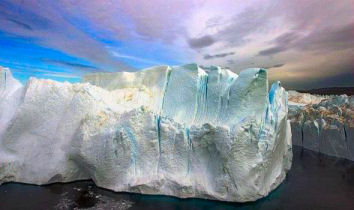 Polar
ice is increasing
Polar
ice is increasing |
The
IPCC argue their research shows that man-made global
warming will lead to extreme weather events becoming
more frequent and unpredictable.
US
News and World Report noted that many of the world’s
largest businesses, including Coke, Pepsi, Walmart,
Nestle, Mars, Monsanto, Kellogg, General Mills, Microsoft,
and IBM, "are now engaged and actively responding
to climate science and data."
Mr
Coleman's comments come as President Barack Obama came
under fire from climatologists as federal data revealed
The United State's energy-related carbon pollution rose
2.5 per cent despite the President's pledges to decrease
it.
President
Obama told 120 world leaders at the United Nations climate
summit last month that America had done more under his
watch in cutting greenhouse gases than any other country.
Despite
this, the Energy Information Administration's Monthly
Energy Review showed an increase in the use of energy
from coal.
World leaders have pledged to keep the global average
temperature from rising two degrees Celsius above pre-industrial
levels to prevent the worst consequences of climate
change.
 The
UK, along with the US and other developed countries,
is expected to pledge further actions on climate change
early next year. The
UK, along with the US and other developed countries,
is expected to pledge further actions on climate change
early next year.
Climate expert William Happer, from Princeton University,
supported Mr Coleman's claims.
He
added: "No chemical compound in the atmosphere
has a worse reputation than CO2, thanks to the single-minded
demonisation of this natural and essential atmospheric
gas by advocates of government control and energy production.
"The
incredible list of supposed horrors that increasing
carbon dioxide will bring the world is pure belief disguised
as science."
In
2010 a high-level inquiry by the InterAcademy Council
found there was "little evidence" to support
the IPCC's claims about global warming.
It
also said the panel had purposely emphasised the negative
impacts of climate change and made "substantive
findings" based on little proof.

There has been no recorded
global warming for 18 years
|
| Supermarket
Seafood Survey |
|
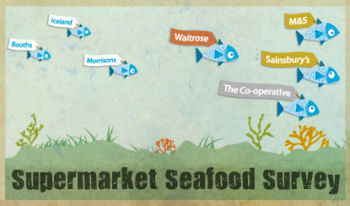 A
recent survey by the Marine Conservation Society
has uncovered just how seriously UK supermarkets are
taking the sustainability of their seafood. We've been
delving into the nitty gritty of their seafood policies,
sourcing, labelling etc. - and the results are very
interesting! A
recent survey by the Marine Conservation Society
has uncovered just how seriously UK supermarkets are
taking the sustainability of their seafood. We've been
delving into the nitty gritty of their seafood policies,
sourcing, labelling etc. - and the results are very
interesting!
How
does your local supermarket score?
Some retailers have shown a real improvement. Sainsbury's
and Marks & Spencer are leading the way in joint
first, whilst the Co-operative comes in close second
and Waitrose third.
Lack of participation by some supermarkets, however,
is keeping consumers in the dark when it comes to choosing
sustainable seafood.
If supermarkets aren’t being transparent
about where and how their seafood is being sourced and
sold then how can consumers have trust in the sustainability
of the fish being sold to them?
Tesco, which has the highest market share of
seafood of all the UK’s supermarkets declined to
take part in our survey, which assesses retailers’
seafood policies, own brand sources and labelling, as
well as other indicators of how seriously supermarkets
take sustainability. Aldi also chose not to participate
this year with Asda, Lidl, Spar and Budgens not even
responding.
We think traceability and labelling of seafood
still needs improvement from all retailers: “In
many cases seafood has a longer supply chain than meat.
We know that some fish caught in UK waters is then sent
halfway across the world, often to Asia, to be processed
and then transported back here and sold in our supermarkets,”
says Samuel Stone.
“What’s needed in the supply chain are
the 3T’s - trust, transparency and traceability
– to make sure that seafood doesn’t have its
own ‘horsemeat’ scandal to deal with.”
Whilst
improvements have been made, labeling and consumer
awareness continues to be an issue for even the leading
retailers. New labeling laws come into effect this year,
which means that shoppers should start to see better
information on seafood products, including how the fish
was caught, where it was caught or farmed, and the full
species name. We believe that if shoppers can’t
see this information on their seafood products - including
those sold online - they should choose something else.
This information is essential when consumers are checking
products against the MCS fish advice website www.fishonline.org
|
| How
"Jaws" misrepresented the great white |
|
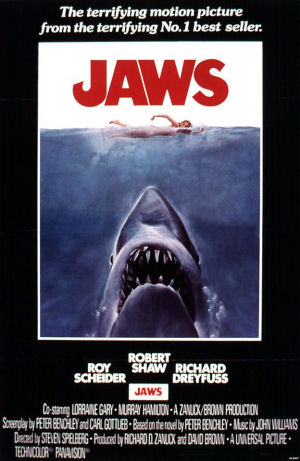 Billed
as "The terrifying motion picture from the terrifying
No 1 bestseller," Jaws has shaped the way many
of us view sharks. But the creatures don't deserve their
vicious reputation. Billed
as "The terrifying motion picture from the terrifying
No 1 bestseller," Jaws has shaped the way many
of us view sharks. But the creatures don't deserve their
vicious reputation.
It was the summer of 1975 and even feeding the goldfish
seemed fraught with danger. There was discernible tension
at the seaside, and an earworm of two notes became a
trigger for fear. Dum Dum, dum dum dum dum…
Forty years ago Jaws the movie hit the big screen. Cinemas
everywhere held audiences in thrall at the thought of
an oversized great white shark with bad attitude coming
to a beach near you.
"Jaws was a turning point for great white sharks,"
says Oliver Crimmen, who's been the fish curator at
the Natural History Museum in London for more than 40
years. "I actually saw a big change happen in the
public and scientific perception of sharks when Peter
Benchley's book Jaws was published and then subsequently
made into a film."
The key problem Jaws created was to portray sharks as
vengeful creatures. The story revolves around one shark
that seems to hold a grudge against particular individuals
and goes after them with intent to kill.
It's loosely based on a real incident in 1916 when a
great white attacked swimmers along the coast of New
Jersey.
"A collective testosterone rush certainly swept
through the east coast of the US," says George
Burgess, director of the Florida Program for Shark Research
in Gainesville. "Thousands of fishers set out to
catch trophy sharks after seeing Jaws," he says.
"It was good blue collar fishing. You didn't have
to have a fancy boat or gear - an average Joe could
catch big fish, and there was no remorse, since there
was this mindset that they were man-killers."
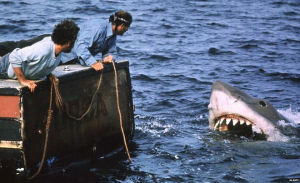 The
author of Jaws, Peter Benchley, (who collected an award
in 1975 marking the sale of a million copies of Jaws)
was deeply perturbed by this. "Knowing what I know
now, I could never write that book today," he said,
years later. "Sharks don't target human beings,
and they certainly don't hold grudges." The
author of Jaws, Peter Benchley, (who collected an award
in 1975 marking the sale of a million copies of Jaws)
was deeply perturbed by this. "Knowing what I know
now, I could never write that book today," he said,
years later. "Sharks don't target human beings,
and they certainly don't hold grudges."
He spent much of the rest of his life campaigning
for the protection of sharks.
Burgess suggests the number of large sharks fell by
50% along the eastern seaboard of North America in the
years following the release of Jaws.
And research by biologist Dr Julia Baum suggests that
between 1986 and 2000, in the Northwest Atlantic Ocean,
there was a population decline of 89% in hammerhead
sharks, 79% in great white sharks and 65% in tiger sharks.
This change is not just down to sport fishing however,
which is small beer compared to the numbers killed as
by-catch from commercial fishing, and for use in shark
fin soup which is popular in Asia.
But since the 1990s, protection for great whites has
been established in many parts of the world including
California, Australia, New Zealand and South Africa.
This has helped numbers recover somewhat, but there
is a long way to go to return to pre-1975 levels.
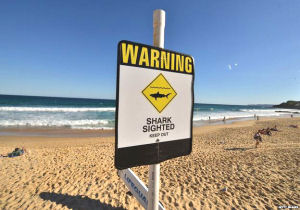 There
is no denying though that Jaws touched something deep
in our psyche. As the streamlined shape of the shark
rocketed upwards to grab yet another victim, so our
fear of sharks surfaced. There
is no denying though that Jaws touched something deep
in our psyche. As the streamlined shape of the shark
rocketed upwards to grab yet another victim, so our
fear of sharks surfaced.
"Sharks in cinema before 1975 were a different
category altogether," says John Mullarkey, professor
of film and television at Kingston University. "After
Jaws, this massive creature, 20ft to 30ft long can devour
you whole… this was a strange discovery for the
public imagination."
It is no surprise that we love to feel frightened by
creatures like sharks and peer out between fingers over
our eyes at movies like Jaws.
"We are not afraid of predators, we're transfixed
by them," says renowned Harvard zoologist Edward
Wilson. We are "prone to weave stories and fables
and chatter endlessly about them, because fascination
creates preparedness, and preparedness, survival - in
a deeply tribal way, we love our monsters".
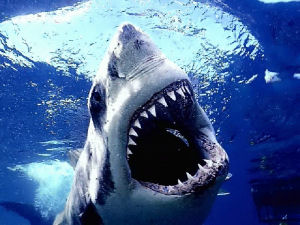 In
reality, some large shark species certainly do attack
humans - about 10 people a year are killed, usually
by great white, bull and tiger sharks. Rarely though
are the victims actually eaten - often they die from
trauma. In
reality, some large shark species certainly do attack
humans - about 10 people a year are killed, usually
by great white, bull and tiger sharks. Rarely though
are the victims actually eaten - often they die from
trauma.
There are two common reasons cited for attacks. Firstly,
sharks mistake swimmers for their usual prey such as
seals, especially if they thrash about in water and
wear shiny objects that resemble fish skin. Secondly,
sharks take an exploratory bite to see if we are suitable
food and when they discover we are puny fare, we are
spat out.
Some researchers take issue with this however - a shark's
vision is too good and its sense of smell too sophisticated
to confuse us with a seal, argue RA Martin, Neil Hammerschlag,
and Ralph Collier from the ReefQuest Center for Shark
Research. These are supreme ocean predators and are
highly unlikely to make clumsy and possibly costly mistakes.
Sharks also have senses not available to most other
animals. Pressure-sensitive pores scattered over their
head and down the body mean they detect the slightest
changes in pressure, enabling them to discern the smallest
of movements even when other senses are restricted -
such as their sight in murky water.
Sharks also possess sophisticated electroreceptors which
help them hone in on the tiny electrical fields present
around all living things, even creatures buried in sand.
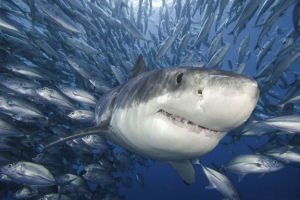 Such
highly-tuned animals are not likely to misidentify something
as large as a human being. Far more likely, they conclude,
is that sharks such as great whites see humans as fellow
predators that could compete with them for food. Such
highly-tuned animals are not likely to misidentify something
as large as a human being. Far more likely, they conclude,
is that sharks such as great whites see humans as fellow
predators that could compete with them for food.
When they attack us they are not interested in eating
us, they want us to leave the area. Martin, Hammerschlag
and Collier have studied many shark attacks and say
that prior to targeting a human, they show aggressive
postures as a warning, and when that message is ignored
they take action. The statistics appear supportive.
The US averages 19 shark attacks each year but only
one fatality every two years.
It is now 40 years since Jaws changed our perception
of the ocean, and slowly but surely its grip is relaxing.
There is an increase in concern for shark welfare and
a greater understanding of the creatures as fascinating
and impressive predators.
The calls for their protection are getting louder and
although most people find it hard to love them, sharks
are garnering more respect. We are less likely to criminalise
them and more prone to accept their presence. It is
a trend that would have delighted Peter Benchley.
|
| Beachwatch |
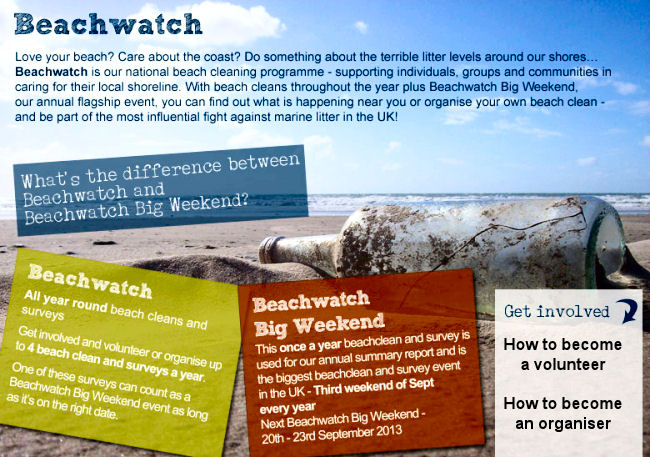 |
| Marine
Conservation Zone proposals withdrawn |
|
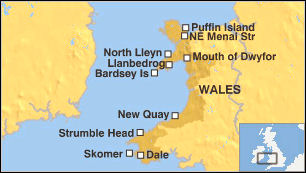 Proposals
to create Marine Conservation Zones in Wales have been
scrapped. Natural Resources Minister Alun Davies made
the announcement in a statement released this morning. Proposals
to create Marine Conservation Zones in Wales have been
scrapped. Natural Resources Minister Alun Davies made
the announcement in a statement released this morning.
Many people in Wales rely upon
and use our seas to support their livelihoods and recreational
activities. We want this to continue and develop as
part of our blue growth agenda.
Last year we consulted on options for highlyprotected
Marine Conservation Zones (MCZs). This generated a substantial
responsethat expressed divergent and strongly held views.
A task and finish team, supported by a Stakeholder Focus
Group, was established to consider and advise how we
should take forward MCZs in Wales. I have met with both
of these groups to thank them for their positive and
constructive contribution throughout the process.
I will be taking forward the recommendations of the
task and finish team and to avoid any continuing uncertainty
over the options presented in the 2012 consultation,
I am also withdrawing all the proposed sites.
– Alun Davies AM, Natural Resources Minister
The proposals faced criticism from those whose living
depends on the sea or tourism who feared it could seriously
harm their livelihoods.
A total of 10 sites were proposed from Puffin Island
on the eastern tip of Anglesey, along the Lleyn Peninsula,
down Cardigan Bay to Dale and Skomer in Pembrokeshire.
Mr Davies says he now wants to understand more about
the marine habitats and species already protected in
Marine Protected Areas.
|
| Llantrisant
Sub-Aqua Club wins a Conservation Award |
|
At
the 2012 SAA AGM in Daventry on April 21st
our club was awarded the "George Arnold Trophy"
for services to Conservation throughout 2011.
Among the many reasons for winning the award were;
our membership of the Marine Conservation Society;
having a section devoted to marine conservation
in our club constitution; having a marine awareness
officer on our club committee; having a Marine
Conservation Section (this page) on our web site
being involved in various marine conservation
projects such a SeaSearch and helping out with
NARCS.
This is the first time that our club has won such
an award and we now have a reputation to keep
up. It is therefore vitally important that all
members understand this and that the Dive Marshalls
ensure that the Club Rules are followed and upheld
on dive days.
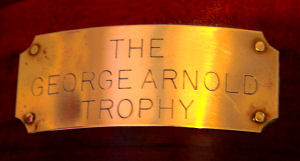
|
| |
|
| Coral
Reefs: by Peter Rees |
|
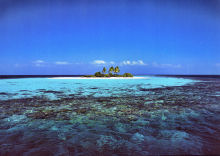 Coral
reefs are underwater structures made from calcium
carbonate secreted by corals. Coral
reefs are underwater structures made from calcium
carbonate secreted by corals.
Corals are colonies of tiny living animals found
in marine waters containing few nutrients. Most
coral reefs are built from stony corals, and are
formed by polyps that live together in groups.
The polyps secrete a hard carbonate exoskeleton
which provides support and protection for the
body of each polyp. Reefs grow best in warm, shallow,
clear, sunny and agitated waters.
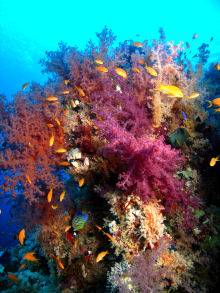 Often
called “rainforests of the sea”, coral
reefs form some of the most diverse ecosystems
on earth. They occupy less than 1% of the world
ocean surface, about half the area of France,
yet they provide a home for 25% of all marine
species, including fishes, molluscs, echinoderms
and sponges. Often
called “rainforests of the sea”, coral
reefs form some of the most diverse ecosystems
on earth. They occupy less than 1% of the world
ocean surface, about half the area of France,
yet they provide a home for 25% of all marine
species, including fishes, molluscs, echinoderms
and sponges.
Paradoxically, coral reefs flourish even though
they are surrounded by ocean waters that provide
few nutrients. They are most commonly found at
shallow depths in tropical waters, particularly
in the Pacific Ocean, but deep water and cold
water corals exist on a much smaller scale.
Coral reefs deliver ecosystem services to tourism,
fisheries and shoreline protection. The annual
global economic value of coral reefs has been
estimated at $30 billion. However, coral reefs
are fragile ecosystems, partly because they are
very sensitive to water temperature. They are
under threat from climate change, ocean acidification,
blast fishing, cyanide fishing for aquarium fish,
overuse of reef resources, and harmful land-use
practices. High nutrient levels such as those
found in runoff from agricultural areas can harm
reefs by encouraging excess algae growth.
 Live
coral should be thought of as small live animals
embedded in calcium carbonate. It is a mistake
to think of coral as plants or rocks. Coral consists
of accumulations of individual animals called
polyps, arranged in diverse shapes. Polyps are
usually tiny, but they can range in size from
a pinhead to about a foot across. Reefs grow as
polyps along with other organisms deposit calcium
carbonate, (the basis of coral), as a skeletal
structure beneath and around themselves, pushing
the coral's "head" or polyps upwards
and outwards. Live
coral should be thought of as small live animals
embedded in calcium carbonate. It is a mistake
to think of coral as plants or rocks. Coral consists
of accumulations of individual animals called
polyps, arranged in diverse shapes. Polyps are
usually tiny, but they can range in size from
a pinhead to about a foot across. Reefs grow as
polyps along with other organisms deposit calcium
carbonate, (the basis of coral), as a skeletal
structure beneath and around themselves, pushing
the coral's "head" or polyps upwards
and outwards.
Waves, grazing fish (such as parrotfish), sea
urchins, sponges, and other forces and organisms
act as bioeroders, breaking down coral skeletons
into fragments that settle into spaces in the
reef structure or form sandy bottoms in associated
reef lagoons.
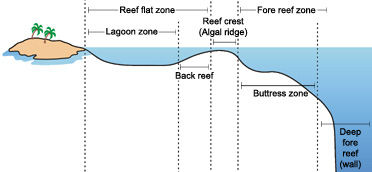 Many
other organisms living in the reef community contribute
skeletal calcium carbonate in the same manner. Many
other organisms living in the reef community contribute
skeletal calcium carbonate in the same manner.
Coralline algae are important contributors to
reef structure in those parts of the reef subjected
to the greatest forces by waves (such as the reef
front facing the open ocean). These algae deposit
limestone in sheets over the reef surface, thereby
strengthening it.
Reef-building or hermatypic corals are only found
in the photic zone (above 50 m depth), the depth
to which sufficient sunlight penetrates the water
for photosynthesis to occur. Coral polyps do not
photosynthesize, but have a symbiotic relationship
with single-celled organisms called zooxanthellae;
these cells within the tissues of the coral polyps
carry out photosynthesis and produce excess organic
nutrients that are then used by the coral polyps.
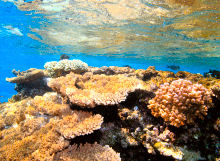 Because
of this relationship, coral reefs grow much faster
in clear water, which admits more sunlight. Indeed,
the relationship is responsible for coral reefs
in the sense that without their symbionts, coral
growth would be too slow for the corals to form
impressive reef structures. Corals get up to 90%
of their nutrients from their zooxanthellae symbionts. Because
of this relationship, coral reefs grow much faster
in clear water, which admits more sunlight. Indeed,
the relationship is responsible for coral reefs
in the sense that without their symbionts, coral
growth would be too slow for the corals to form
impressive reef structures. Corals get up to 90%
of their nutrients from their zooxanthellae symbionts.
Types of Coral Reefs
Most reef scientists generally recognize three
basic types of coral reefs:
|
|
1.
Fringing Reefs
2. Barrier
Reefs
3. Atolls
|
 |
The
differences between these three main reef types
are pronounced in terms of large-scale structure.
Nonetheless, there is often a good deal of similarity
between them within a given biogeographic region
in terms of species composition and ecological
interactions.
1. Fringing Reefs
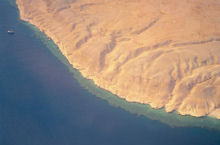 The
first major coral reef type is the fringing reef,
which is a reef system growing fairly close to
or directly from shore with an entirely shallow
(less than about 10m) lagoon, or no lagoon at
all. The
first major coral reef type is the fringing reef,
which is a reef system growing fairly close to
or directly from shore with an entirely shallow
(less than about 10m) lagoon, or no lagoon at
all.
These are by far the most common reef type in
the Red Sea and Greater Caribbean region. Fringing
reefs also surround many islands of French Polynesia
(South Pacific) and the Indian Ocean.
Many islands within atolls have fringing reefs
often referred to as the "house reef".
Patch Reefs are outcrops of coral usually offshore
but often found within the lagoon of a Barrier
Reef or Atoll.
Because they are situated relatively close to
island or mainland shores, fringing reefs are
generally the most susceptible to coastal development,
agriculture, pollution, and other human activities
that result in sedimentation and freshwater runoff.
2. Barrier Reefs
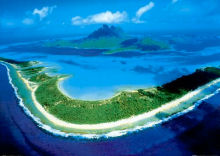 Barrier
reefs (center photo; above) are reef systems that
parallel the shore and are separated from it by
a wide lagoon that contain at least some deep
portions. Examples of large barrier reefs can
be found in both the Indo-Pacific and Greater
Caribbean, with the Great Barrier Reef of Australia
being the prime example. Barrier
reefs (center photo; above) are reef systems that
parallel the shore and are separated from it by
a wide lagoon that contain at least some deep
portions. Examples of large barrier reefs can
be found in both the Indo-Pacific and Greater
Caribbean, with the Great Barrier Reef of Australia
being the prime example.
The very largest barrier reefs develop on the
edges of continental shelves (e.g., Great Barrier
Reef; Belize Barrier Reef). These massive reef
complexes are sometimes referred to as "shelf
barrier reefs" in order to differentiate
them from the much smaller barrier reefs surrounding
some islands found in the South Pacific (e.g,
Bora-Bora).
The back reef zones and lagoons of shelf barrier
reefs are often very extensive, in some cases
lying over 100 miles from the mainland in some
areas. In contrast, the barrier reef surrounding
the narrow lagoon of Bora Bora (photo, above right)
actually transitions into a fringing reef in a
few places.
3. Atolls
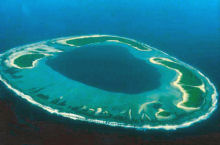 Atolls
are roughly circular (or occasionally horseshoe-shaped)
oceanic reef complexes surrounding a large, deep
central lagoon. Atolls
are roughly circular (or occasionally horseshoe-shaped)
oceanic reef complexes surrounding a large, deep
central lagoon.
Atolls are most common in the Indo-Pacific region
where over 300 atolls are found, but rare in the
Greater Caribbean which houses only about 10-15.
The four best developed Caribbean atolls are found
off southern Mexico and the coast of Belize.
Atolls can exceed 100 miles in diameter and contain
lagoons several thousand square miles in extent.
The best developed parts of reefs surrounding
atolls are on the windward side, where wave energy
is greatest.
|
|
| David
Bellamy on Global Warming |
|
 FOR
YEARS David Bellamy was one of the best known
faces on TV. FOR
YEARS David Bellamy was one of the best known
faces on TV.
A respected botanist and the author of 35 books,
he had presented around 400 programmes over the
years and was appreciated by audiences for his
boundless enthusiasm.
Yet for more than 10 years he has been out of
the limelight, shunned by bosses at the BBC where
he made his name, as well as fellow scientists
and environmentalists.
His crime? - Bellamy says he
doesn’t believe in man-made global warming.
Bellamy says "When I first stuck my head
above the parapet to say I didn’t believe
what we were being told about global warming I
had no idea what the consequences would be.
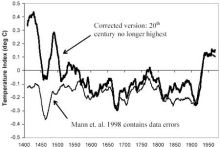 I
am a scientist and I have to follow the directions
of science but when I see that the truth is being
covered up I have to voice my opinions. I
am a scientist and I have to follow the directions
of science but when I see that the truth is being
covered up I have to voice my opinions.
According to official data, in every year since
1998 world temperatures have been getting colder,
and in 2002 Arctic ice actually increased. Why,
then, do we not hear about that?
The sad fact is that since I said I didn’t
believe human beings caused global warming I’ve
not been allowed to make a TV programme.
 My
absence has been noticed, because wherever I go
I meet people who say: “I grew up with you
on the television, where are you now?” My
absence has been noticed, because wherever I go
I meet people who say: “I grew up with you
on the television, where are you now?”
It was in 1996 that I criticised wind farms while
appearing on Blue Peter and I also had an article
published in which I described global warming
as poppycock.
The truth is, I didn’t think wind farms were
an effective means of alternative energy so I
said so. Back then, at the BBC you had to toe
the line and I wasn’t doing that.
Bellamy says we must stop destroying tropical
rainforests.
At the beginning of this year there was a BBC
show with four experts saying: “This is going
to be the end of all the ice in the Arctic,”
and hypothesising that it was going to be the
hottest summer ever. Was it hell! It was very
cold and very wet and now we’ve seen evidence
that the glaciers in Alaska have started growing
rapidly – and they’ve not grown for
a long time.
 I’ve
seen evidence, which I believe, that says there
has not been a rise in global temperature since
1998, despite the increase in carbon dioxide being
pumped into the atmosphere. This makes me think
the global warmers are telling lies – carbon
dioxide is not the driver. I’ve
seen evidence, which I believe, that says there
has not been a rise in global temperature since
1998, despite the increase in carbon dioxide being
pumped into the atmosphere. This makes me think
the global warmers are telling lies – carbon
dioxide is not the driver.
The idiot fringe have accused me of being like
a Holocaust denier, which is ludicrous. Climate
change is all about cycles, it’s a natural
thing and has always happened. When the Romans
lived in Britain they were growing very good red
grapes and making wine on the borders of Scotland.
It was evidently a lot warmer.
If you were sitting next to me 10,000 years ago
we’d be under ice. So thank God for global
warming for ending that ice age; we wouldn’t
be here otherwise.
 People
such as former American Vice-President Al Gore
say that millions of us will die because of global
warming which I think is a pretty stupid thing
to say if you’ve got no proof. And Al Gore
has no proof. People
such as former American Vice-President Al Gore
say that millions of us will die because of global
warming which I think is a pretty stupid thing
to say if you’ve got no proof. And Al Gore
has no proof.
And my opinion is that there is absolutely no
proof that carbon dioxide is anything to do with
any impending catastrophe. The science has,
quite simply, gone awry. In fact, it’s not
even science any more, it’s anti-science.
There’s no proof, it’s just projections
and if you look at the models people such as Gore
use, you can see they cherry pick the ones that
support their beliefs.
 To
date, the way the so-called Greens and the BBC,
the Royal Society and even our political parties
have handled this smacks of McCarthyism at its
worst. To
date, the way the so-called Greens and the BBC,
the Royal Society and even our political parties
have handled this smacks of McCarthyism at its
worst.
Global warming is part of a natural cycle and
there’s nothing we can actually do to stop
these cycles. The world is now facing spending
a vast amount of money in tax to try to solve
a problem that doesn’t actually exist.
And how were we convinced that this problem exists,
even though all the evidence from measurements
goes against the fact? God knows. Yes, the lakes
in Africa are drying up. But that’s not global
warming. They’re drying up for the very simple
reason that most of them have dams around them.
 So
the water that used to be used by local people
is now used in the production of cut flowers and
vegetables for the supermarkets of Europe. So
the water that used to be used by local people
is now used in the production of cut flowers and
vegetables for the supermarkets of Europe.
One of Al Gore’s biggest clangers was saying
that the Aral Sea in Uzbekistan was drying up
because of global warming. Well, everyone knows,
because it was all over the news 20 years ago,
that the Russians were growing cotton there at
the time and that for every ton of cotton you
produce you use a vast amount of water.
The thing that annoys me most is that there are
genuine environmental problems that desperately
require attention. I’m still an environmentalist,
I’m still a Green and I’m still campaigning
to stop the destruction of the biodiversity of
the world. But money will be wasted on trying
to solve this global warming “problem”
that I would much rather was used for looking
after the people of the world.
 Being
ignored by the likes of the BBC does not really
bother me, not when there are much bigger problems
at stake. Being
ignored by the likes of the BBC does not really
bother me, not when there are much bigger problems
at stake.
I might not be on TV any more but I still go around
the world campaigning about these important issues.
For example, we must stop the destruction of tropical
rainforests, something I’ve been saying for
35 years.
Mother nature will balance things out but not
if we interfere by destroying rainforests and
overfishing the seas.
That
is where the real environmental catastrophe could
occur!!
|
|
|
|
| |
|
|
| |
|
Marine
Conservation Zones - Update
|
|
 The
Welsh Assembly is dropping all 10 highly protected
Marine Conservation Zones in Welsh seas. The
Welsh Assembly is dropping all 10 highly protected
Marine Conservation Zones in Welsh seas.
Their new plan is to undertake a review of the
current network and use new MCZ sites to fill
any gaps.
It is good to hear that stakeholders will be kept
informed and consulted on site management issues.
But now, quick progress is essential - given that
the MCZ sites should have been designated by 2012!
|
|
| Microplastics
- Scrub Them Out! |
|
 Did
you know that tiny plastic particles (microbeads)
are lurking in hundreds of toiletries available
in the UK? Did
you know that tiny plastic particles (microbeads)
are lurking in hundreds of toiletries available
in the UK?
Businesses should be encouraged to stop this environmentally
unfriendly use of plastic! Take the pledge to
Scrub It Out!
A quick phase out of microbeads
is crucial
Tiny
particles of plastic have been added to possibly
thousands of personal care products sold around
the world.
These microbeads, hardly visible to the naked
eye, flow straight from the bathroom drain into
the sewer system. Wastewater treatment plants
are not designed to filter out microbeads and
that is the main reason why, ultimately, they
contribute to the Plastic Soup swirling around
the world’s oceans.
Sea creatures absorb or eat microbeads. These
microbeads are passed along the marine food chain.
Since humans are ultimately at the top of this
food chain, it is likely that we are also absorbing
microbeads from the food we eat.
Microbeads are not biodegradable and once they
enter the marine environment, they are impossible
to remove.
Positive action on behalf of manufacturers has
meant that more and more of these microbeads are
being removed from personal care products and
replaced by naturally biodegradable alternatives.
It is still a far cry to say that all personal
care products are free from plastic microbeads
though.
|
|
| Basking
Shark Code of Conduct |
|
 The
Basking Shark (Cetorhinus maximus) is one of the
few species that has emerged from being an important
commercially targeted fish, to becoming a charismatic
wildlife ambassador. The
Basking Shark (Cetorhinus maximus) is one of the
few species that has emerged from being an important
commercially targeted fish, to becoming a charismatic
wildlife ambassador.
Once heavily targeted for their liver oil, meat
and fins, the last UK fishing operation ceased
only in the mid-1990s and in 1998 this species
received protection under the Wildlife and Countryside
Act (1981).
Now protected, this species cannot be targeted,
retained or disturbed in British waters.
Every year, holidaymakers flock to the coastline
in the hope of seeing these enigmatic sharks for
themselves.
Reaching lengths of up to 12m, Basking Sharks
are the largest fish in British waters and the
second largest in the world after the Whale Shark
(Rhincodon typus).
One of only three plankton-feeding shark species,
these gentle giants re-appear in our coastal waters
each spring and summer.
The following guidelines
have been designed to help boat handlers reduce
the risk of killing, injuring or
harassing Basking Sharks:
Boat Handlers:
-
Restrict
your speed to below 6 knots and avoid sudden
speed changes.
-
When
closer than 100 m switch the engine to neutral
to avoid injuring sharks.
-
Avoid
disturbing dense groups of sharks as you may
disrupt courtship behaviour.
-
Be
extremely cautious in areas where Basking
Sharks have been seen breaching.
-
Jet-skis
are incompatible with Basking Sharks and should
stay at least 500 m away.
-
Remember
that for every shark visible on the surface
there are likely to be more hidden just below.
The
following guidelines have been designed to help
swimmers and divers reduce the risk of injuring
or
harassing Basking Sharks:
Divers, Snorkellers and Swimmers:
-
Do
not try to touch the sharks.
-
Maintain
a distance of 4 m from each shark and be wary
of the tail.
-
Groups
of swimmers should stay together and ideally
remain at the surface.
-
Restrict
the number of people in the water at any one
time.
-
Take
plenty of pictures but avoid flash photography
which can scare the sharks. Photograph any
characteristic features which may help re-identify
the shark in the future.
-
Do
not use underwater propelled devices.
Tips
Under
Schedule 5 of the Wildlife and Countryside
Act (1981) it is illegal to kill, injure or recklessly
disturb Basking Sharks in British waters.
Any person committing such an ofence could face
up to 6 months in prison.
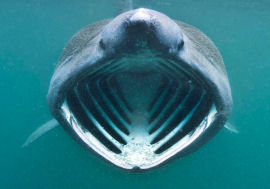
www.baskingsharks.org
|
|
|
|
|
|
|
|
|
| Thousands
of jellyfish on Welsh beach |
|
 Thousands
of barrel jellyfish have been found wahed up on
the shore at Cefn Sidan beach in Pembrey near
Llanelli. Thousands
of barrel jellyfish have been found wahed up on
the shore at Cefn Sidan beach in Pembrey near
Llanelli.
A further 50 of them, thought to have been attracted
by the high sea temperature, were also spotted
at Burry Port Harbour on Saturday.
The slimy creatures known as Barrel Jellyfish
and sometimes called Dustbin Lids are the largest
jellyfish species found in UK waters.
 They
usually make an appearance every year but their
numbers have increased this year, partly due to
the warm spell of weather and the high levels
of nutrients in the sea. They
usually make an appearance every year but their
numbers have increased this year, partly due to
the warm spell of weather and the high levels
of nutrients in the sea.
They are mostly harmless and lead amazing lives
being a vital part of our wildlife. It is likely
the tide will take them back out to sea over the
next few days.
The rare leatherback turtle eat the jellyfish
and sightings are expected across the Carmarthenshire
coast this summer.
Barrel jellyfish numbers have increased in recent
years as mild winters allow plankton, which they
feed on, to thrive.
They have a mild sting, said to be similar to
that of nettles, and which can cause a rash.
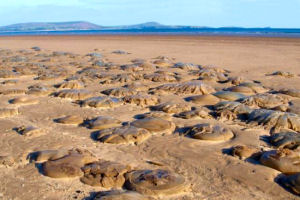
This
sighting comes the day after a photographer approached
a 'dead snake' on another Welsh beach only to
find it was very much alive.
|
|
| British
Sharks |
|
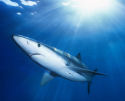 Contrary
to popular belief sharks do occur around the coasts
of Britain. Contrary
to popular belief sharks do occur around the coasts
of Britain.
In fact there are over 30 species, including some
of the fastest, rarest, largest and most highly
migratory sharks in the world. But sadly over
50% of the UK’s shark species are under threat.
At least 21 species of shark are resident inhabitants
and commonly found around the coasts of Britain
all year round, such as the Smallspotted Catshark,
Porbeagle Shark and Basking Shark.
Blue Sharks and Shortfin Mako Sharks are seasonal
visitors, appearing in British waters in summer
during their trans-Atlantic migrations. A few
species, Smooth Hammerhead and Frilled Shark may
be vagrants, occurring infrequently off the British
coast, with their main distribution ranges being
outside British waters.
At least 11 shark species, including the Portuguese
Dogfish, Black Dogfish, Kitefin Shark and Gulper
Sharks are only found in deep water.
|
|
| British
Fish Stock Recovery |
|
 A
new report suggests fish stocks are turning a
corner. A
new report suggests fish stocks are turning a
corner.
MCS says enough time must given before we can
start getting some stocks back on the menu.
A new report published today by the University
of Aberdeen indicates that some fish species in
the North East Atlantic region are showing signs
of recovery, with stock numbers beginning to stabilise
and showing signs of growth
The authors of the paper go so far as to link
this encouraging news with the management measures
laid out in the Common Fisheries Policy (CFP)
over the last decade.They warn that the CFP, which
is currently being reviewed, needs to be seen
for its positive impacts, as well as fix its well-publicised
weaknesses
Jim Masters, MCS Aquaculture and Fisheries Programme
Manager, says "This report makes really encouraging
reading, and comes at an important time. We welcome
any data that indicates a recovery, however small,
and we are optimistic that the outlook for fishing
and fish stocks is improving in some cases.
It is vital to note, however, that many of the
species studied are only at the foothills of real
recovery. It will take time for stock levels to
recover to their full potential, which will deliver
greater benefit us all in the long-run. Meanwhile
we must continue our efforts to call for a continued
recovery, confident that fish stocks at full reproductive
levels are both possible and more profitable.
"Reforms to the Common Fisheries Policy should
further improve the situation for all European
fish stocks: a continued reduction in fishing
pressure, more sustainable catching methods and
a legal requirement to end over-fishing will all
help speed up the recovery forecast in this report."
MCS believes that this is particularly true for
cod - an iconic species for us here in the UK.
Recent headlines have portrayed the current status
of stocks in the North Sea as a reason to encourage
consumers to "eat cod again". This is
a miss-representation of the situation, and is
not supported by the best available science.
Jim Masters continues "Cod is showing signs
of recovery in some places, but a big increase
in fishing effort at this stage would leave stocks
vulnerable to heading straight back into crisis
point. What we're saying is that, whilst there
may be signs of recovery, there is a long way
to go before stocks are at a healthy state as
defined by science.
If we start suggesting people can eat cod 'worry'
free right now the North Sea stocks will quickly
slip back to dangerously low levels. We must be
patient if we want to return to eating cod from
the North Sea with confidence."
|
|
|
|
|
|
|
|
|
|
|
| |
|
|
| |
| Llantrisant
Sub-Aqua Club wins a Conservation Award |
|
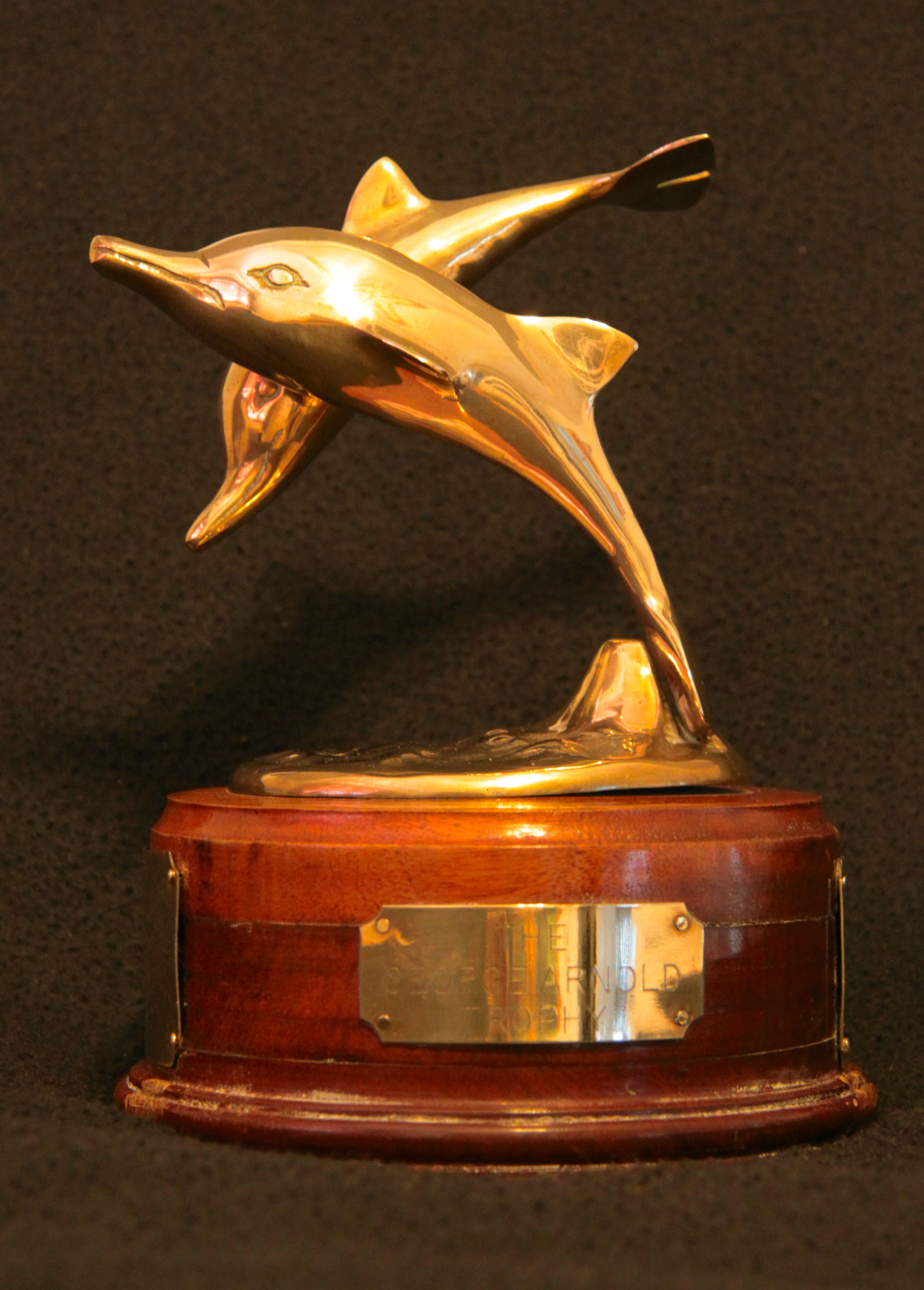 At
the 2012 SAA AGM in Daventry on April 21st
our club was awarded the "George Arnold Trophy"
for services to Conservation throughout 2011. At
the 2012 SAA AGM in Daventry on April 21st
our club was awarded the "George Arnold Trophy"
for services to Conservation throughout 2011.
Among the many reasons for winning the award were;
our membership of the Marine Conservation Society;
having a section devoted to marine conservation
in our club constitution; having a marine awareness
officer on our club committee; having a Marine
Conservation Section (this page) on our web site
being involved in various marine conservation
projects such a SeaSearch and helping out with
NARCS.
This is the first time that our club has won such
an award and we now have a reputation to keep
up. It is therefore vitally important that all
members understand this and that the Dive Marshalls
ensure that the Club Rules are followed and upheld
on dive days.

|
| |
|
| Pembrokeshire
National Park |
|
 With
the Pembrokeshire National park turning 60 years
old this year, I think it only fitting to focus
on the Pembrokeshire Coast, with its breath-taking
scenery, diverse wildlife, and it's beautiful
weather (well most of the time), as most of our
diving takes place down in West Wales, I thought
that it might be interesting to know a little
about the parks history, and its various marine
ecosystems. With
the Pembrokeshire National park turning 60 years
old this year, I think it only fitting to focus
on the Pembrokeshire Coast, with its breath-taking
scenery, diverse wildlife, and it's beautiful
weather (well most of the time), as most of our
diving takes place down in West Wales, I thought
that it might be interesting to know a little
about the parks history, and its various marine
ecosystems.
Pembrokeshire
national park encompasses the entire South-West
coastline of Wales, from Manobier around to Abereiddy,
including the islands of Skomer, Ramsey, Grassholm,
Skokholm, and The Smalls. The park has been in
existence since February, 1952, covering around
240 square miles, 180 miles of which is coastline
which can be walked, uninterrupted, along the
"Pembrokeshire Coastal Path". Also the
park became a European Marine Special Area of
Conservation in December 2004, which gives the
UK a total of 81 SAC sites, and making the park
part of the 2% of the UK seas now incorporated
into SAC sites.
A
Map of the Coastal Area covered under the European
SAC
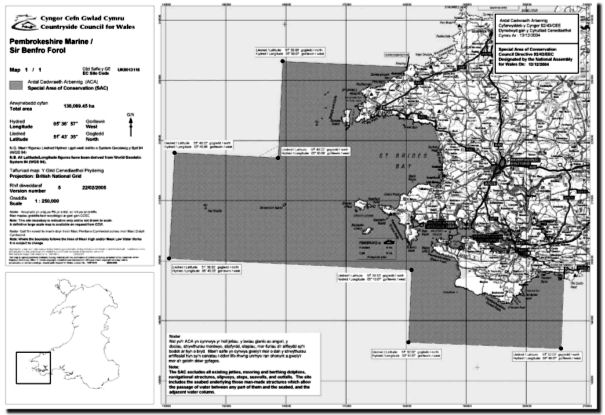
Image taken from: http://www.pembrokeshiremarinesac.org.uk/images/Map_1.gif
The national park contains many different ecosystems,
each with its own collection of endangered and
rare species, yet as divers the ecosystems we
are the most familiar with, are the marine environments.
There are a number of habitats around the Pembrokeshire
coast, from the cold water reefs that stretch
westward into the Irish sea, surrounding Skomer
and The Smalls, are home to a great variety of
marine wildlife, from cold-water Corals, Sponges,
Sea Urchins, Starfish, Jellyfish, Crustaceans(Lobsters
and Crab), species of fish, and larger mammal
species of Seals and Porpoises. A prime example
of this marine habitat are located on the north
and south sides of Skomer, where many rare species
can be found, such as the Scarlett and Gold Star
Coral, Balanophyllia regia.
A
Photograph of a Scarlett and Gold Start Coral
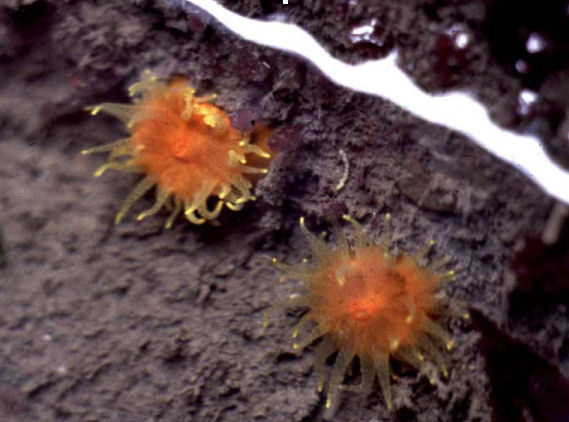
Image Taken From: http://www.marlin.ac.uk/imgs/o_balreg5.jpg
The
immense population of seabird species on the isolated
islands of Grassholm, Skomer and Skokholm, such
as Puffins, Cormorants, many species of Gulls,
Terns, and Kittiwakes. All of which use the jagged
cliffs, or grassy tops of the islands for nesting,
and the plentiful surrounding seas for feeding,
with many of these seabirds migrating in the winter
months. These islands also house the West Wales
collection of Common and Grey Seals, which live,
feed and raise their young on the rocky outcrops,
pebble beaches and cliffs. With West Wales population
of Grey Seals being the most southerly breeding
population known in Europe.
A Photograph of a Grey Seal
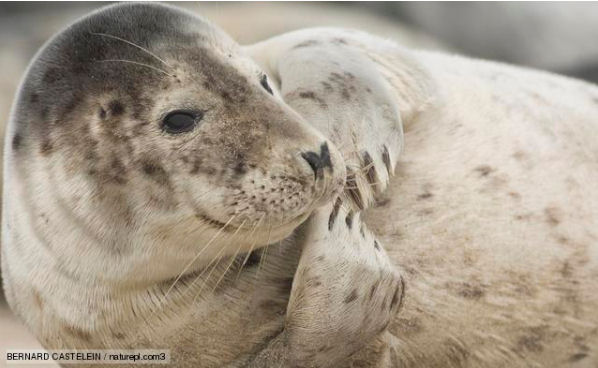
Image Taken From: http://www.bbc.co.uk/nature/images/ic/credit/640x395/g/gr/gray_seal/gray_seal_1.jpg
I
hope that this has been an interesting read and
maybe if you want to know more about Pembroke
National Park, the websites below contain further
information.
www.pembrokeshirecoast.org.uk
www.visitpembrokeshire.com
www.wwmc.org.uk
www.pembrokeshiremarinesac.org.uk
|
|
| Underwater
Photography Equipment Sale |
|
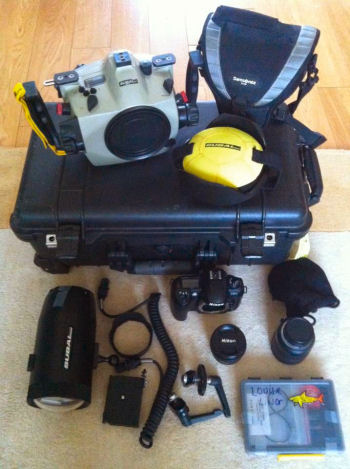 Dear
Llantrisant Divers Dear
Llantrisant Divers
My name is Louise Ling, former member 1996ish.
I am looking to sell my underwater photography
equipment which I purchased second hand (very
good condition) in 2007 from wetpixel.com, from
Austria (its Subal housing). Reason for selling
is that I havent used it since 2010 and am also
looking to upgrade. All parts will need to be
serviced as havent use equipment since 2010. Would
prefer to sell as entire unit.
Equipment
located in Beddau and would prefer a local sale
rather than sending by UPS. Let me know if you're
interested and we can talk prices.
I thought I would send the enquiry your way first
before I post it onto various websites, althought
I tried FB but not much success.
Please can you circulate this and if anyone's
interested to call me on 07581 300756
email:
louise_ling@hotmail.com / linglouise77@gmail.com.
Thanks!
Louise
Packing
list as follows:
-
1
SUBAL housing for the digital SLR-camera Nikon
D100 & 1Nikon D100 digital SLR-camera
(Both had a service in 2009 - Bought for €2400)
-
1
Dome-port with O-ring protection cover (Domeport
DP-SWB SUBAL 6 - Bought for €350)
-
1
SUBAL housing for Nikon Strobe & 1 Nikon
Strobe Speedlight SB 80 DX (Flash SB 80DX
Subal Housing (without changing possiblities
underwater) and a cable -Bought for €350)
-
1
Strobe cable Nikon
-
1
Nikon 20Mm F2.8D Af Nikkor Lens (good for
wide angle shots) Bought for €400
-
1
Nikon Nikkor Zoom lens 18 mm - 70 mm - F/3.5-4.5
- Nikon F Bought for €275
-
1
Pelican 1510 Hard Case with Foam Bought for
€190
-
1
Battery-pack
-
1
Battery Charger and power cable
-
1
Toolpack (Silicon-grease, 3 diff. wrenches)
-
1
Strobe-arm system (not pictured - but in my
dive bag) Bought for €275
|
|
| Special
Notice |
|
NOTICE
TO MARINERS
Ramsey
Sound, Pembrokeshire
Core
Sample and Deposit of Scientific Instruments
Notice is hereby given that on or about 23rd August
2011 for a period of approximately 5 days, the
vessel "Island Trader II" (10m aluminium
landing craft) and a support vessel will be involved
in removing a seabed core sample and installing
scientific instruments in the northern part of
Ramsey Sound, Pembrokeshire within the vicinity
of grid coordinates 51 Degrees 52'.66N, 05 Degrees
19'.56W
The
works will consist of diver activity and lowering
equipment to the seabed. Work will be carried
out in daylight hours only and no marker buoys
will be present.
Mariners
are advised to navigate with caution within 200m
of this vessel during the works.
|
Tidal
Energy Limited
Vision House
Oak Tree Court
Cardiff Gate Business Park
Cardiff, CF23 8RS
Tel
No. 02920 730900
Web
Site:
www.tidalenergyltd.com
15th
August 2011
|
|
|
|
| Pembrokeshire
Coastal National Park Authority Consultation Document |
 Probably,
the most important section for us as divers is the
section below found on pages 62 & 63 of the
document, in particular the paragraph highlighted
in blue: Probably,
the most important section for us as divers is the
section below found on pages 62 & 63 of the
document, in particular the paragraph highlighted
in blue:
Please Note: The deadline for any comments, suggestions,
etc. is January 31st 2011 |
|
5.4.4
Marinas, harbours and slipways
The
Welsh Assembly Government's Watersports strategy,
"Catching the Wave" recorded 11 harbours,
marinas and yacht stations in Pembrokeshire. In
addition, planning permission has been granted for
2 major new marina developments at Fishguard and
Pembroke Dock, providing 540 and 260 berths respectively
when complete.
The
operation of the marina in Fishguard in particular
will need careful management because to the immediate
West the overfall areas off Strumble Head are important
for cetaceans and rafting seabirds, the cliffed
beaches of much of the North coast are critical
sites for seal pupping and much of the coast as
far as Cemaes Head is greatly valued for its remote
and wild qualities.
|
Milford
Haven Water Ranger. The
Milford Haven Port Authority and the PCNPA
have worked together for many years to create
a water ranger post, specifically to support
the Milford Haven harbourmaster on recreation
issues. This can involve patrols, monitoring,
enforcement, education and assistance to
all recreational users.
|
These
major sites are supplemented by around 20 smaller
harbours and mooring areas around the coastline
outside the Haven, mostly locally regulated and
charged at low annual rates.
There are around 50 slipways and launching points
in the county, these are mainly unmanaged and
give free, unregulated access to the estuary and
sea.
Actions for section 5.4.4
|
Many
of these slipways especially around the Dale peninsula
are at the end of long, single track roads or in
tight locations which are not suitable for launching
increasingly large vessels. We will seek to encourage
use of more appropriate sites for large craft –
e.g. dive boats and fishing boats, where there is
better infrastructure and parking.
We
recognise the social and economic benefits that
these sites bring to the local economy. However
the sheer number and range of launch sites means
that it is hard to introduce management to ensure
that users and operators follow environmental codes
of practice and are suitably insured and skilled
to operate their craft.
From
the point of view of sustainability, tranquillity
and impact on other users and wildlife, we would
wish to promote sailing, rowing and other non-motorised
recreation in particular from these sites.
We will look for sustainability improvements in
marinas and harbours and work though partnerships
such as the Milford Haven Waterway Recreation Group
to encourage good practice in dealing with such
issues as sewage discharges, removal of scraped
antifouling, control of bilge water discharges and
provision of recycling facilities.
Important
web links:
|
|
ACTION
1
|
We
will work with partners to develop better
launch facilities for dive craft at
more accessible locations (e.g. Gelliswick,
Goodwick). |
|
ACTION
2
|
Ensure
that, as part of the development agreement
of any new marinas, the operators agree
a code of good practice with their clients
and that this is effectively applied. |
|
ACTION
3
|
Encourage
local adoption and where necessary,
charging for slipway management, as
a way of managing access points and
meeting maintenance costs. |
|
ACTION
4
|
Recognise
that the ability to manage PWCs on slipways
and on the water is limited because
of low numbers and many launch points.
Seek to discourage use in the National
Park, through publicity and information. |
|
PWC
= Personal Water Craft
(would include club boats)
|
Notes:
- We
would not be opposed to a reduction of launch
sites providing there is adequate provision
for divers to access the dive sites around the
Haven, the islands and St. Brides Bay.
- We
have our own Code of Conduct which we adhere
to when using launch sites within the National
Park
- We
would be happy to comply with any additions
to a code of conduct to promote sustainability
and reduce the impact on the local environment
and wildlife.
- Our
boats are ALWAYS operated by suitably trained
personel
- Our
boats are ALWAYS insured against 3rd party liability
- We
would be happy to become partners to help in
the development and sustainability of launch
sites and becoming involved in any decision
making process.
- The
use of Gelliswick and Goodwick in "Action
1" as examples
of launch sites for dive boats, presumably,
does not exclude the possibility of other launch
sites being used.
|
|
| Haven
Diver’s Presentation |
|
 On
Saturday 10th September, Haven Diving Services
hosted an evening especially for recreational
divers. The event which was held at the Lord Nelson
Hotel in Milford Haven was attended by sixty people
representing dive clubs from all around Wales. On
Saturday 10th September, Haven Diving Services
hosted an evening especially for recreational
divers. The event which was held at the Lord Nelson
Hotel in Milford Haven was attended by sixty people
representing dive clubs from all around Wales.
Tom Luddington, Activities Liaison Officer
for the Countryside Council for Wales opened the
evening and gave some interesting statistics,
there has been an 18% increase in visitor numbers
coming specifically for bird watching, 18% more
walkers and 6% more people engaging in water sports.
Diver numbers however have remained static. Tom
went on to say that the National Park was voted
second best coastal region by National Geographic.
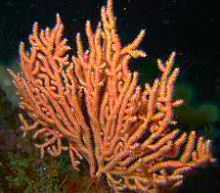 Following
on from Tom, Sue Burton from the Marine Conservation
Society showed a selection of slides illustrating
life below the waves. The images taken mostly
by local divers showed fish life, sponges and
crustaceans. Sue went on to talk about the valuable
work carried out by MCS which has contributed
to improvements in water quality and fish stocks. Following
on from Tom, Sue Burton from the Marine Conservation
Society showed a selection of slides illustrating
life below the waves. The images taken mostly
by local divers showed fish life, sponges and
crustaceans. Sue went on to talk about the valuable
work carried out by MCS which has contributed
to improvements in water quality and fish stocks.
She urged people not to become complacent and
praised the work carried out by groups such as
Narcs who encourage people to get involved in
beach and underwater clean ups as a way of improving
conditions around the Welsh Coastline.
Disappointingly, there no-one from fisheries
protection available to attend. Tom Luddington
made a valiant attempt to provide answers to the
confusions that often arise around take limits
but it would have been helpful if there had been
a fisheries’ officer present as divers had
many questions about commercial lobster fishing
that needed answers.
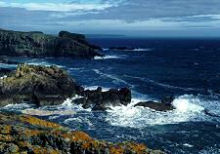 Phil.
Newman, Marine Nature Officer working around
the reserve, explained the work carried out by
himself and a team of dedicated wardens which
included monitoring activity both on the water
and around the islands. He told how the delicate
balance of the eco-system could be affected by
human intervention and encouraged divers to be
mindful of certain beaches during the seal breeding
season and reminded people about the no anchoring
rule which helped protect the reef. Phil.
Newman, Marine Nature Officer working around
the reserve, explained the work carried out by
himself and a team of dedicated wardens which
included monitoring activity both on the water
and around the islands. He told how the delicate
balance of the eco-system could be affected by
human intervention and encouraged divers to be
mindful of certain beaches during the seal breeding
season and reminded people about the no anchoring
rule which helped protect the reef.
Phil made divers aware of the guides available
free of charge including a waterproof version
that should be carried on every dive boat.
After a short break which included a superb
buffet, Dave Kennard, from Haven Dive Services
and a panel including Charles Mathieson, Head
of Recreation and Tourism invited questions from
the floor.
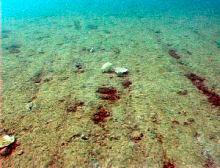 There
were queries and observations about the damage
to the sea bed caused by scallop dredging and
questions about the number of lobster pots being
used particularly around Skomer.These
were answered by Sue Burton and Phil Newman. Charles
Mathieson. There
were queries and observations about the damage
to the sea bed caused by scallop dredging and
questions about the number of lobster pots being
used particularly around Skomer.These
were answered by Sue Burton and Phil Newman. Charles
Mathieson.
In answer to issues around diver access
they acknowledged that divers often have to share
facilities with other beach users and this was
not always ideal.
During discussions about a Diver Code of
Conduct it was agreed that current guidelines
were out of date, Dave Wakelam, Chairman of the
Welsh Association of sub-Aqua Clubs, invited divers
to send suggested inclusions for a new guide to
the Association via the e-mail link.
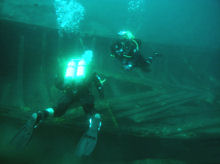 The
last presentation of the evening was an interesting
set of images of wrecks in and around the Haven.
Mark Gosling and a team from Cardiff BSAC had
used a side scanner to find wreck sites, some
of which were well known to divers, others though
weren’t including a recent wreck discovered
off Crow Rock. Mark’s presentation included
some excellent video footage. The
last presentation of the evening was an interesting
set of images of wrecks in and around the Haven.
Mark Gosling and a team from Cardiff BSAC had
used a side scanner to find wreck sites, some
of which were well known to divers, others though
weren’t including a recent wreck discovered
off Crow Rock. Mark’s presentation included
some excellent video footage.
The meeting ended at 9-30pm and people
were invited to help themselves to an array of
useful literature from the Marine Conservation
Society and the Countryside Council for Wales.
Tom Luddington’s request for a show of hands
in favour of a similar event next year brought
a positive response and Haven Divers were congratulated
for a very informative presentation.

|
|
|
| |
| Orcas
spotted off Pembrokeshire |
|
 Birdwatchers
on a day trip off the west Wales coast spotted
two killer whales instead. Birdwatchers
on a day trip off the west Wales coast spotted
two killer whales instead.
The 40-strong group were training their telescopes
and binoculars out to sea at Fishguard when they
spotted a 6ft fin cutting through the water.
There have been reports of the mammals off the
coast before but they are still a rare sighting.
Cliff Benson, who was among the party from the
mid Pembrokeshire section of the Wildlife Trust
South and West Wales, said it "blew your
socks off."
Killer whales can grow up to 28 feet long and
eat seals, dolphins and other whales.
Mr Benson said: "We did not expect to see
anything at first because some jet skis shot by
and scared most of the birds away.
 "But
then somebody saw a big fin and there were about
40 of us all with telescopes and binoculars so
that got us looking for things. Suddenly there
were several big fins out there. "But
then somebody saw a big fin and there were about
40 of us all with telescopes and binoculars so
that got us looking for things. Suddenly there
were several big fins out there.
"The first ones were definitely Risso's dolphins,
which are bigger than the usual flipper-type dolphins.
"Then somebody saw an even bigger fin about
six foot tall and the white eye patches and white
flanks of what everybody recognises from the Free
Willy films - an orca or killer whale.
"There were two of them, possibly a male
and female.
"They were about a mile off the coast. You
would not have seen them without telescopes or
binoculars, but they are there. It blows your
socks off."
As well as killer whales, several species of shark
have been recorded in the coastal waters, including
the enormous basking shark, according to the Pembrokeshire
National Park Authority.
It said pilot whales and sun fish had also made
appearances but sightings were relatively rare.
|
|
| Protect
Chagos |
|
 Now,
before its too late, there is an opportunity to
save one of the greatest marine environments left
on earth. Now,
before its too late, there is an opportunity to
save one of the greatest marine environments left
on earth.
The Chagos Archipelago represents a magnificent
conservation opportunity that could be of lasting
benefit to humanity.
There can be few places on this planet that represent
better value for leveraging spectacular returns.
What is needed is vision and a leadership initiative
by Britain to create the Chagos as an iconic,
pristine area held in trust for the future of
the world community.
The Chagos Archipelago also known as the British
Indian Ocean Territory is an area of 210,000 square
miles and is located about 300 miles south of
the Maldives.
STOP PRESS: (see adjacent
article)
LONDON 01:04:2010 — Secretary of State David
Miliband today designated the Chagos, Archipelago
as a no-take marine reserve.
This declaration will make it the largest marine
protected area in the world, an area twice the
size of the U.K.
The combination of tropical islands, unspoiled
coral reefs and adjacent oceanic abyss makes this
area comparable in global importance to the Great
Barrier Reef or Galapagos Islands.
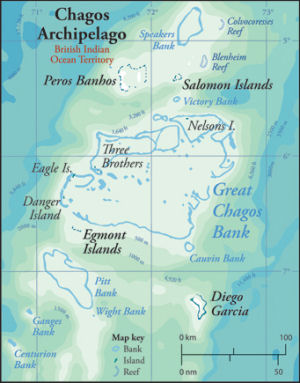
|
|
| Bite
Back Campaign |
|
 Sharks
are widely regarded as a predatory 'eating machines'
that don't discriminate between fish or humans.
This irrational fear has earned them a reputation
as being dangerous and worthy of contempt. Sharks
are widely regarded as a predatory 'eating machines'
that don't discriminate between fish or humans.
This irrational fear has earned them a reputation
as being dangerous and worthy of contempt.
As a result, sharks have taken on trophy-like
qualities for the people that hunt and eat them.
This lust for money and a taste for the exotic
has landed sharks in deep trouble.
 Right
now, sharks are among the most valuable and vulnerable
animals in the sea. Right
now, sharks are among the most valuable and vulnerable
animals in the sea.
Massive consumer demand for shark fins and other
shark related products have created an industry
motivated by high return.
Shark fins have become one of the world's most
precious commodities reaching figures of up to
$256 per pound. It was recently reported that
the dorsal fin of a whale shark alone fetched
$15,000 at market.
 It
is barely surprising then that more than 125 countries
around the world now trade in shark products contributing
to an uncontrollable surge in the number of shark
taken from the oceans. In a little over 50 years
the slaughter of sharks has risen 400 per cent
to approximately 800,000 metric tons per year. It
is barely surprising then that more than 125 countries
around the world now trade in shark products contributing
to an uncontrollable surge in the number of shark
taken from the oceans. In a little over 50 years
the slaughter of sharks has risen 400 per cent
to approximately 800,000 metric tons per year.
By 2017 it is anticipated that 20 species of shark
could become extinct due to hunting, indiscriminate
fishing techniques and, ultimately, man's greed.
 Currently
more than 100 million sharks are taken from the
seas each year - a rate at which they simply cannot
survive. Currently
more than 100 million sharks are taken from the
seas each year - a rate at which they simply cannot
survive.
They cannot survive this onslaught because, unlike
many other fish, most large sharks don't reach
sexual maturity until seven years old or even
later, and then only give birth to a few pups
each year.
Right now, they are simply being caught and killed
faster than they can reproduce.
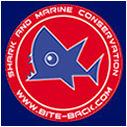 Bite-Back
and its supporters together can encourage consumers
to make informed choices, change their habits
and actively motivate and inspire establishments
that sell shark products to stop. Bite-Back
and its supporters together can encourage consumers
to make informed choices, change their habits
and actively motivate and inspire establishments
that sell shark products to stop.
When we stop buying shark meat and fins, they'll
stop fishing for it.
See the Bite
Back Campaign for more information on
how you can help reduce the trade in shark meat
and other threatened species.
|
|
| Marine
Coastal Access Bill |
|
 In
late 2009 Parliament will enact the Marine and
Coastal Access Bill. This new law will establish
a new network of marine conservation zones to
protect species and habitats of national importance. In
late 2009 Parliament will enact the Marine and
Coastal Access Bill. This new law will establish
a new network of marine conservation zones to
protect species and habitats of national importance.
The Welsh Assembly Government has the aim for
the Welsh marine environment, as set out in the
Environment Strategy for Wales, to ensure clean
seas that will enable healthy and functioning
ecosystems that are biologically diverse and resilient.
In order to achieve this aim, however, it is vital
to understand what is biologically significant
in Wales’ marine environment, in order than
conservation zones are correctly sited to achieve
the conservation aims intended.
Throughout 2009, volunteer SCUBA divers have surveyed
the biology of the Pembrokeshire coast, through
the Marine Conservation Society’s Seasearch
programme, in a weekly programme of intensive
marine surveys.
In
this open public lecture, Ms. Vicky Swales (Seasearch
Instructor) will present the results of the 2009
marine surveys and discuss the significance of
the biogeography and importance of marine species
for Wales. The likely impact of the Marine and
Coastal Access Bill on Wales, and the introduction
of Marine Protected Areas will also be discussed.
Anyone
with an interest in marine biology, marine biogeography
and SCUBA diving is more than welcome to attend.
Date:
Wednesday 14th October
Venue: Room GT9012,
Glyntaf Campus,
University of Glamorgan
Time: 19:30
Contact: Simon Jones, sdjones2@glam.ac.uk
or 01443 654 490
|
|
|
Portuguese
Man-O-War in Pembrokeshire |
|
 BATHERS
are being warned about the possible presence of
Portuguese man o’war jellyfish on Pembrokeshire’s
beaches. BATHERS
are being warned about the possible presence of
Portuguese man o’war jellyfish on Pembrokeshire’s
beaches.
During
the last week, four of the creatures — which
carry a poisonous sting in their trailing tentacles
— have been found washed up on Amroth beach
in the south of the county with another six found
on the water’s edge.
Lifeguards
spotted two more just along the coast on the South
Beach in the popular resort of Tenby with another
three being spotted in Mill Bay near St Anne’s
Head at the mouth of the Milford Haven waterway.
The notices, which are being erected by the county
council at more than 30 of Pembrokeshire’s
Blue Flag and Green Flag beaches, warn of the
possible presence of Portuguese man o’war
jellyfish.
Swimmers
are also advised to stay in lifeguarded areas
where possible.
 Anyone
seeing a jellyfish is advised to inform the lifeguard
or contact a beach warden on 07770 574242 or 07721
861005. Anyone
seeing a jellyfish is advised to inform the lifeguard
or contact a beach warden on 07770 574242 or 07721
861005.
Council
spokesman, Len Mullins, said: “The Portuguese
man o’war is a rare visitor to these shores
and the chances of swimmers actually encountering
one in the water while bathing are extremely slim.
“However
they do possess a sting said to be ten times stronger
than an ordinary jellyfish and swimmers should
be aware of their possible presence.”
Treatment
for the sting – which leaves whip-like, red
welts on the skin – involves washing with
salt water and then applying ice to dull the pain.
|
|
| The
Portuguese Man-O-War |
|
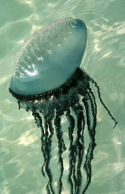 Anyone
unfamiliar with the biology of the venomous Portuguese
man-of-war would likely mistake it for a jellyfish.
Not only is it not a jellyfish, it's not even
an "it," but a "they." The
Portuguese man-of-war is a siphonophore, an animal
made up of a colony of organisms working together. Anyone
unfamiliar with the biology of the venomous Portuguese
man-of-war would likely mistake it for a jellyfish.
Not only is it not a jellyfish, it's not even
an "it," but a "they." The
Portuguese man-of-war is a siphonophore, an animal
made up of a colony of organisms working together.
The
man-of-war comprises four separate polyps. It
gets its name from the uppermost polyp, a gas-filled
bladder, or pneumatophore, which sits above the
water and somewhat resembles an old warship at
full sail. Man-of-wars are also known as bluebottles
for the purple-blue color of their pneumatophores.
The
tentacles are the man-of-war's second organism.
These long, thin tendrils can extend 165 feet
(50 meters) in length below the surface, although
30 feet (10 meters) is more the average. They
are covered in venom-filled nematocysts used to
paralyze and kill fish and other small creatures.
For humans, a man-of-war sting is excruciatingly
painful, but rarely deadly. But beware—even
dead man-of-wars washed up on shore can deliver
a sting.
Muscles
in the tentacles draw prey up to a polyp containing
the gastrozooids or digestive organisms. A fourth
polyp contains the reproductive organisms.
Man-of-wars
are found, sometimes in groups of 1,000 or more,
floating in warm waters throughout the world's
oceans. They have no independent means of propulsion
and either drift on the currents or catch the
wind with their pneumatophores. To avoid threats
on the surface, they can deflate their air bags
and briefly submerge.
|
|
| The
Great Stingray Migration |
|
Gulf
of Mexico
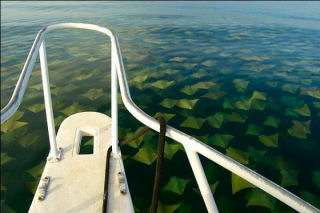
Like
autumn leaves floating in a sunlit pond, this
vast expanse of magnificent stingrays animates
the bright blue seas of the Gulf of Mexico.
Taken
off the coast of Mexico's Holbox Island by amateur
photographer Sandra Critelli, this breathtaking
picture captures the migration of thousands of
rays as they follow the clockwise current from
Mexico's Yucatan peninsula to western Florida.
Measuring
up to 6ft 6in across, poisonous golden cow-nose
rays migrate in groups - or 'fevers' - of up to
10,000 as they glide their way silently towards
their summer feeding grounds.
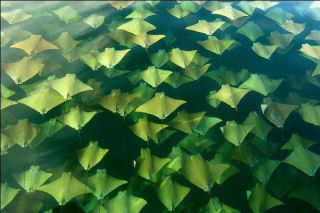
They
migrate twice yearly: north in late spring (as
pictured here) and south in late autumn.
There
are around 70 species of stingray in the world's
oceans, but these cow-nose rays (Rhinoptera bonasus)
have distinctive, highdomed heads, giving them
a curiously bovine appearance.
But
despite their placid looks, they are still armed
with a poisonous stinger, which can be deadly
to humans (even though sharks, their main predators,
are more likely to provoke them).
The
stinger, a razor-sharp spine that grows from the
creature's whip-like tail, can reach almost 15
inches in length and carries a heady dose of venom.
It
was a similar stinger that killed the hugely popular
Australian naturalist Steve Irwin in 2006.
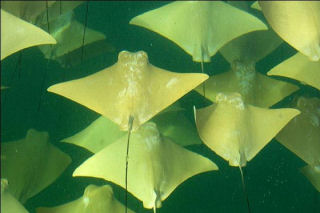
But
even equipped with this powerful punch, cow-nose
stingrays are shy and non-threatening in large
'fevers'. Even when isolated, they will attack
only when cornered or threatened.
Unlike other stingrays, they rarely rest on the
seabed (where unsuspecting humans can step on
them) and prefer to be on the move.
They
migrate long distances, and can be found as far
south as the Caribbean and as far north as New
England.
They
use their extended pectoral fins to swim, and
often turn upside down, curling their fin tips
above the surface of the water - leaving terrified
swimmers convinced that they have seen a shark.
Their flexible fins also come in handy when rustling
up food. By flapping them rapidly over the seabed,
they stir up sand and reveal crabs, shellfish
and oysters, which they then feed on using their
powerful, grinding teeth.
Their
particular fondness for shellfish has made them
public enemy number one with oyster fishermen.
But
despite this, their numbers are exploding, thanks
in part to rising sea temperatures. They mate
every winter, and females produce a litter of
five to ten young.
Stingrays (which are related to skates and sharks)
have never been widely fished for food, mainly
because of their rubbery flesh.
But
barbecued stingray and dried fins are common in
Singapore and Malaysia, while pickled stingray
remains a traditional favourite in Iceland.
|
|
| A
letter from Vicky Swales |
|
(former
club marine conservation officer)
 Dear
All Dear
All
Hope you all have had a good summer of diving!
We have had several good Seasearch dives
in the last few weeks with some good visibility
and interesting seabed habitats but sadly
no Mantis Shrimps!. Those of you that would
still like to join us on a Seasearch dive
for the remainder of 2006 have a choice
of three dates left.
Wednesday 30th August, Sunday 10th September
and Sunday 17th September. If your interested
in joining us then please fill in the attachment
and return ASAP as places are filling up
quickly.
We also have a Seasearch Observer course
on Saturday 16th September, 9am - 4.30pm
at Hampshire Wildlife Trust in Botley. Again
please fill in the attachment if interested.
I would also like to ask if anyone is interested
in attending a Seasearch Surveyor course?
I know that several of you have enquired
earlier on in the year about the Surveyor
course and we are hoping to run one in October
subject to demand. I have provisionally
booked the weekend of the 7th/8th. You need
to already be a Seasearch observer and have
a up-do-date log book with all paperwork
signed off. This two day course does requires
a a dive on the second day for completion.
Please can you reply by Monday 11th September
to confirm if you are interested in attending
so I can finalise arrangements.
I do hope that you can join us on a Seasearch
dive soon.
Cheers, Vicky
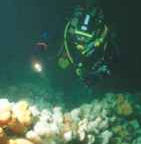 Seasearch
Dives Seasearch
Dives
Volunteers are to meet at Hayling Island
Ferry Pontoon on the Eastney side at 10am
for the 30th August, and 9am for both dives
in September.
Cost of dives is £15 subject to weather
conditions. Dive site, IOW. Further details
will be send once your booking form is received.
Please particularly make note of the following
points: Copies of the following must be
shown to the Dive Marshal before boarding
the vessel:
- Diving
qualification (and training agency).
- Date
of and expiry of doctors medical examination
or UK sport diver medical self-certification.
- Who
provides your diver third party insurance?
(e.g BSAC, SAA, DAN, PADI) if you are
not already insured, please ensure you
arrange cover prior to the course.
- Date
of most recent sea dive (log book) Due
to Health and Safety requirements, divers
who do not show all paperwork on the day
will not be allowed to dive, so it is
important to make sure that all information
is presented to the Dive Marshal.
Divers
are advised that a 'Seasearch dive' should
not be their first sea dive or deepest dive
of the season. It is recommended that a
UK 'warm-up' dive has already taken place.

If
you have any questions then please do not
hesitate to contact me, for further information
about Seasearch details can be found on
http://www.seasearch.org.uk
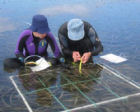 Seasearch
Observer Course Seasearch
Observer Course
This is a one-day course aimed at giving
divers new to the project and new to marine
recording a basic grounding. At the end
of the course you should be able to complete
the Seasearch Observation Form and take
part in Seasearch Dives either on your own,
with your club or on dives organised by
Seasearch Partners.
During the course you'll learn about Seasearch
- its aims, history and achievements, a
basic introduction to the variety of marine
life in UK waters, recognising and classifying
marine habitats, position fixing, and how
to fill in the Observation Form. The day
concludes with a 'video dive' and an opportunity
to fill in a form without even getting wet!
The course includes a splash proof course
pack and everything you'll need to go ahead
and get started.
The tutors are all divers themselves and
drawn from our partner organisations and
keen Seasearchers. A real dive isn't a part
of the course but sometimes one is arranged
locally for you to practice your techniques
with a tutor on hand. During the course
you'll get a Seasearch Qualification booklet.
Once you have completed 5 for real (two
on dives with a Tutor present) you can get
signed up as a Seasearch Observer.
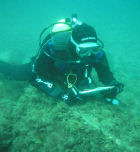 Seasearch
Surveyor Course Seasearch
Surveyor Course
The Surveyor Course is aimed at experienced
Seasearch Observers and others with a good
background knowledge of marine life and
marine recording. The aim is to enable you
to complete the Seasearch Survey Form which
is used on most of the expeditionary Seasearch
dives and which gives much more detailed
information for future conservation purposes.
The course lasts two days and includes a
dive on the second day. The Course content
is an expansion of the Observer Course and
covers a much wider range of marine life
and habitat classification. Again we use
video on the first day and you fill in practice
forms both from the video and from the dive
itself. The course is assessed and successful
participants can become Seasearch Surveyors
after completing a further five forms.
Vicky Swales
|
|
|
|
| Mantas
in Sharm |
|
 April
is a month to celebrate in Sharm as the summer
season finally arrives. April
is a month to celebrate in Sharm as the summer
season finally arrives.
Each year from April to September divers are sometimes
lucky enough to have the company of manta rays
on the local dive sites.
So far this April there have been numerous manta
ray sightings up and down the coastline. No longer
is 'Ras Mohammed' or 'Tiran' the most popular
choice, the 'local' dive sites are the place to
be!
Manta rays, easily distinguished by their large
mandibles, are the biggest winged creatures that
inhabit the oceans. The largest known specimen
measured more than 7.6 metres across with a weight
of about 2,300 kilos. But here in Sharm a smaller,
yet still impressive 3-4 metres is more common.
Mantas feed mainly on plankton filtered from the
water passing through their gills as they swim.
Incidentally their top speed is only 7 miles per
hour and for those of you that have had the chance
to dive with them before, you'll know it seems
like they are going much faster.
Scuba diving with a manta ray is an amazing experience,
often ended with a cheer of delight from the divers
upon reaching the surface.
They are quite curious animals and they are often
known to approach scuba divers, either enjoying
the interaction and playing with our bubbles or
simply wanting to see what is happening.
These magnificent creatures are also frequently
seen feeding near or at the surface so those snorkelling
also might be lucky enough to catch a glimpse.
When diving with manta rays it is very important
to remember that they are wild animals and should
be observed only. The less action a scuba diver
takes to scare a manta ray, such as chasing it
to get a better look or to get that perfect picture,
the more likely it is that the manta ray will
hang around giving an unforgettable experience.
Happy manta ray spotting this summer in Sharm!
|
|
| UK
creates world’s largest marine reserve |
|
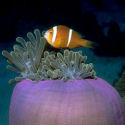 Britain
has created a 210,000 sq mile marine nature reserve
around the Indian Ocean’s Chagos Archipelago,
making it the largest area yet designated for
the protection of marine species. Britain
has created a 210,000 sq mile marine nature reserve
around the Indian Ocean’s Chagos Archipelago,
making it the largest area yet designated for
the protection of marine species.
The group of some 50 islands, a British protectorate,
lies 1000 miles south of India. It features 220
coral species, including the world’s largest
coral atoll.
Twice
the size of Britain, the new reserve is fully
protected, with all commercial fishing and extraction
banned.
Rich
in fish species, the Chagos Islands are an important
breeding ground for important populations of oceanic
sharks, dolphins and green and hawkbill sea turtles.
Protection
from fishing will give these and other creatures,
some of which are on the International Union for
Conservation of Nature’s Red List of endangered
species, a chance to regroup.
In
addition, because the Chagos Island reefs recovered
well from El Nino-instigated coral destruction
in the late 90s, they represent a key base by
which to judge the recovery of other affected
coral areas.
The decision by Britain to protect the Ghagos
Islands came after a four-month public consultation
on the islands’ management. More than 275,000
people and organisations from around the world
participated.
Its establishment will double the global coverage
of the world's oceans under protection which desperately
need better protection.
In 2010, the International Year of Biodiversity,
the UK has secured a conservation legacy which
is unrivalled in scale and significance, demonstrating
to the world that it is a leader in conserving
the world’s marine resources for the benefit
of future generations.
Partners have included the Chagos Conservation
Trust, The Pew Environment Group, the Marine Conservation
Society, the Royal Botanical Gardens in Kew, The
Royal Society, The Royal Society for the Protection
of Birds (RSPB), The Zoological Society of London
(ZSL), The Linnean Society of London and Prof
C Sheppard.
After the Chagos Archipelago, the world’s
second-largest marine reserve, established by
President George W Bush in 2006, lies around the
Northwestern Hawaiian Islands.
At 140,000 square miles, it is a shade larger
than Australia's Great Barrier Reef Marine Park.
|
|
| Welsh
Minister named "Shark Champion" |
|
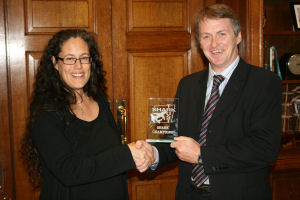
London: The Shark Trust awards; Huw Irranca Davies,
UK Minister for Marine and Natural Environment,
the status of ‘Shark Champion’.
The
Minister received a Shark Champion award today
in recognition of the UK’s prohibition on
the removal of shark fins at sea, and the associated
requirement that UK vessels around the world must
land sharks with their fins naturally attached.
The
Shark Trust Director of Conservation, Ali Hood,
said: "This award to Mr Irranca Davies and
his counterpart in Scotland Mr Lochhead, is the
first of its kind to policy makers and reflects
the decisive action in addressing the issue of
shark finning. It also recognises the UK's ongoing
efforts in urging all EU Member States to follow
their lead.”
The
Shark Trust has advocated for a change in the
EU Shark Finning Legislation since it’s adoption
in 2003. Hood went on to say: "An end to
special fishing permits and a requirement to land
sharks with their fins naturally attached greatly
improves the opportunity for effective shark management.
It also marks significant progress towards implementation
of aspects of the EU Community Plan of Action
for Sharks."
On
receiving his award Mr Irranca Davies said: “Sharks
are some of the most vulnerable species on Earth
and action must be taken to protect them. I am
proud that my decision has allowed the UK to lead
the way in Europe by ending the permits which
allow fins to be removed at sea.
Now all UK registered vessels will have to land
sharks with their fins attached wherever in the
world they are fishing. Not only will this end
the wasteful practice of removing fins and discarding
the bodies at sea, but we’ll also be able
to get better scientific evidence to help conservation.
“I
am grateful to the Shark Trust for their support
as I continue to push in Europe to end the issuing
of these permits for all European countries.”
Shark
finning remains the single greatest threat to
shark populations. The decision to prohibit the
removal of shark fins at sea influences not only
UK vessels within EU waters but also overseas.
With an active fleet of UK pelagic longline vessels
in the Indian Ocean and around the coast of Africa
catching significant numbers of pelagic sharks
legislation of this nature is vital to enable
effective shark fisheries management.
|
|
| Container
Ship Hits Jackson Reef |
|
 A
large cargo vessel has gone hard aground on Woodhouse
Reef, in the northern Red Sea. A
large cargo vessel has gone hard aground on Woodhouse
Reef, in the northern Red Sea.
The 260m-long, Hong Kong-flagged CSCL Hamburg
hit the reef, between the Sinai coast and Tiran
Island, on the morning of New Year’s Eve,
while en route to Singapore.
Diving
operators and others are relieved that, so far,
there appear to have been no leakages from the
hull.
Damage
is reportedly limited to the bow area, but could
be severe as the ship ran on to the reef at a
speed of about 20 knots. There were no injuries
to crew or loss of cargo.
The
extent of damage to corals has yet to be assessed,
and the diving community waits to learn what impact
the grounding will have on diving in the area,
in terms both of any salvage operation and of
damage done to the reef.
John
Kean, a Sharm El Sheikh-based PADI and TDI diving
instructor and author of the book SS Thistlegorm,
saw events unfold from a dive boat some way off,
before moving in for a closer look.
“The
ship passed the first reef, Jackson, at 10am and
instead of continuing past Gordon Reef, the last
of the four reefs in the Tiran Straits, it went
between the middle two reefs, Woodhouse and Thomas,”
he told Divernet.
“The
gap here is less than 80m. The ship, with a beam
of 32.3m, struck Woodhouse Reef just 50m from
its end but went hard on to the top by a distance
of around 25m.”
Kean
later learned that, according to early reports,
the ship deviated when its third officer, temporarily
in charge of the bridge, turned to port to avoid
a small craft.
It
was thought that the officer either over-steered
the vessel or underestimated its ability to turn
back on to a safe course.
 The
Straits of Tiran are popular with scuba divers
coming out of Sharm El Sheikh, for the scenic
drift diving that can be had in the vicinities
of Woodhouse, Jackson, Gordon and Thomas Reefs. The
Straits of Tiran are popular with scuba divers
coming out of Sharm El Sheikh, for the scenic
drift diving that can be had in the vicinities
of Woodhouse, Jackson, Gordon and Thomas Reefs.
Fortunately
no fuel or oil leakages appeared to have occurred,
and that pumps were at work to deal with water
ingress which was limited to the bow area, due
to the ship’s watertight compartments.
|
|
| Diving
for Crabs & Lobsters |
|
 New
pages have been added to this web site with reference
to the byelaws governing the landing of fish and
shellfish by divers. New
pages have been added to this web site with reference
to the byelaws governing the landing of fish and
shellfish by divers.
During a recent committee meeting the subject
was discussed at length and it was decided that
it would be helpful if the regulations were published
on the site for the benefit of the membership.
The regulations are enforced and penalties for
breaching the regulations can be severe and include
large fines and/or confiscation of boats.
The new links are as follows:
South Wales Fisheries
Committee Byelaws
South Wales Fisheries
Guidance Leaflet
EU
Minimum Fish Sizes (PDF)
|
|
| Prime
Minister commits to Marine Bill |
|
 Prime
Minister Gordon Brown has confirmed that the Government
is preparing the long-awaited "Marine Bill"
for introduction early in the fourth Session of
Parliament - possibly within a matter of weeks. Prime
Minister Gordon Brown has confirmed that the Government
is preparing the long-awaited "Marine Bill"
for introduction early in the fourth Session of
Parliament - possibly within a matter of weeks.
This
follows ongoing campaigning by wildlife organisations
MCS, RSPB, WWF and the Wildlife Trusts, including:
a full page advertisement calling for the Bill
in national newspapers; an "Early Day Motion"
put forward in parliament; and support for the
Marine Bill and Marine Reserves by BBC presenters
Kate Humble and Simon King.
It
also coincided 25 years to the day with the Marine
Conservation Society's inaugural registration
as a UK charity.
 The
Marine Bill is vital to enable the designation
of Marine Conservation Zones to protect nationally
important wildlife such as pink sea fans, eel
grass beds, seahorse, maerl and basking sharks.
At present less than 0.001% of our seas are highly
protected from damaging activities. The
Marine Bill is vital to enable the designation
of Marine Conservation Zones to protect nationally
important wildlife such as pink sea fans, eel
grass beds, seahorse, maerl and basking sharks.
At present less than 0.001% of our seas are highly
protected from damaging activities.
|
|
| Maldives
adopts blanket shark-fishing ban |
|
 A
10-year-old moratorium banning shark fishing in
parts of the Maldives has been extended to cover
the whole island group. A
10-year-old moratorium banning shark fishing in
parts of the Maldives has been extended to cover
the whole island group.
Since its adoption in 1998, the moratorium covered
seven atolls - but now it extends to 12 nautical
miles off any Maldives land mass.
The Maldivian Government has taken the step in
the face of evidence that shark populations in
the area have come under threat from fishing practices,
with takes exceeding sharks' abilities to reproduce.
Abdullah Nasir, the Fisheries Ministry's Permanent
Secretary, said: "The fisheries law clearly
tells us that we can protect any marine species
if we feel that it's threatened or endangered
for any reason."
The Maldives is a draw for diving tourists, attracted
by its reputation for healthy populations of sharks,
in particular hammerheads.
Acknowledging that the islands' shark groups are
"very important for tourism", Nasir
added that his ministry was "working towards"
enshrining the moratorium permanently in law,
with the aim of banning shark-fishing and the
export of shark products within the next year.
Conservationists have welcomed the move - but
caution that effects should be monitored. Maldivian
reef ecologist Marie Saleem, while welcoming the
Government's announcement, said that reef shark
populations will require careful assessment to
determine the effect of the moratorium and any
subsequent statutory ban.
Some
observatioins by Rob (Biffo) Bryning of
Maldives Scuba Tours:
We have truly had a great winter season with
superb encounters with all the big stuff.
It’s particularly encouraging to see
the numbers of grey reef sharks back on the
increase. We were worried that they had been
all fished out but, for whatever reason, we
are now seeing regular large shoals of these
wonderful animals. |
|
|
| Crayfish
Study |
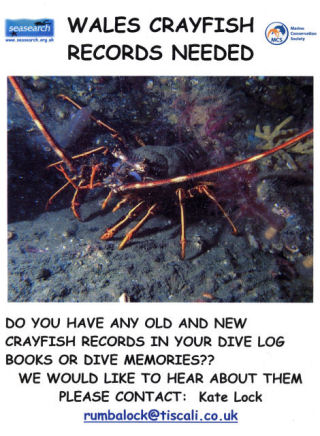
|
|
| Some
marine related news: |
|
The
following snippets are from the Wildlife Trust
marine news section. Some information
about seasearch courses and dives in Wales are
at the end.
- Latest
issue of MPA News, including Skomer, MPAs for
migratory species and more.
click here
- Does
Scotland really need a Marine Act?
click here
-
Scottish consultation on wave and tidal energy.
click here
- Climate
change at the coast – CoastNet conference.
click
here
- Bass
Minimum Landing Size petition. The recreational
sea angling lobby has proposed that the Minimum
Landing Size (MLS) for the taking of bass should
be increased to 45cm which is the size at which
each fish will have spawned at least once. The
commercial industry is generally against this
move. Defra had recognized the importance of
increasing the MLS and last year announced an
interim increase to 40cm starting 6th April
2007 with a view to a larger increase in 2010.
A last minute meeting with the commercial sector
has put a hold on any increase. There is a petition
at the No. 10 Downing Street website to increase
the MLS to 45cm.
click
here
- Plans
for Olympic Marina on Dorset coast.
click
here
- Fishing
off Sussex costs a trawler skipper £10,300.
The owner and skipper of the Brixham beam trawler
Angus Rose, was fined a £6,500 with a
further £3,800 costs, by Brighton magistrates
on March 29th after pleading guilty to 17 log
book offences and fishing inside the protected
six mile limit off Hastings.
In an interview submitted to the court, Mr.
George admitted to Marine Fisheries inspectors
that he never filled his log book until the
end of a fishing trip. The rules state that
he is required to do so by midnight every night.
Prosecuting for the Marine Fisheries Agency
and the Sussex Sea Fisheries Committee, David
Buck, said a large vessel like the Angus Rose
fishing inside the six mile limit had a damaging
impact on the marine environment and in-shore
fish stocks.
Magistrates said it was clear that the Angus
Rose had consistently fished within the six
mile limit and there was no excuse for it because
sophisticated equipment on board showed Mr.
George exactly where he was.
Mr. George claimed the log book offences were
“minor clerical errors” and his encroachment
inside the six mile limit was because he was
short-handed and tired. ”Magistrates said
that after previous warnings, a small fine and
a conditional discharge in the past it was time
to impose a significant financial penalty.
Paul Johnson, senior MFA fisheries officer based
at Shoreham said: “This case shows the
Marine Fisheries Agency and the Sussex Sea Fisheries
Committee working in partnership to enforce
the rules which are designed preserve the inshore
marine environment and fish stocks.”
- Latest
issue of emarine. click
here
including PhD on Citizenship and the Marine
Environment.
- Education:
marine mammals and noise. Canadian lesson plan
on the impacts of noise on harbour porpoises.
click
here
- Shark
fishing upsets ecosystem and damages shellfisheries.
click
here
|
|
| Some
useful photography web resources: |
|
|
|
|
|
|
|
| |
|
|
|
Copyright © 2002 - .... Llantrisant
Sub-Aqua Club. All rights reserved.
|
|